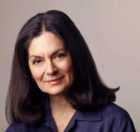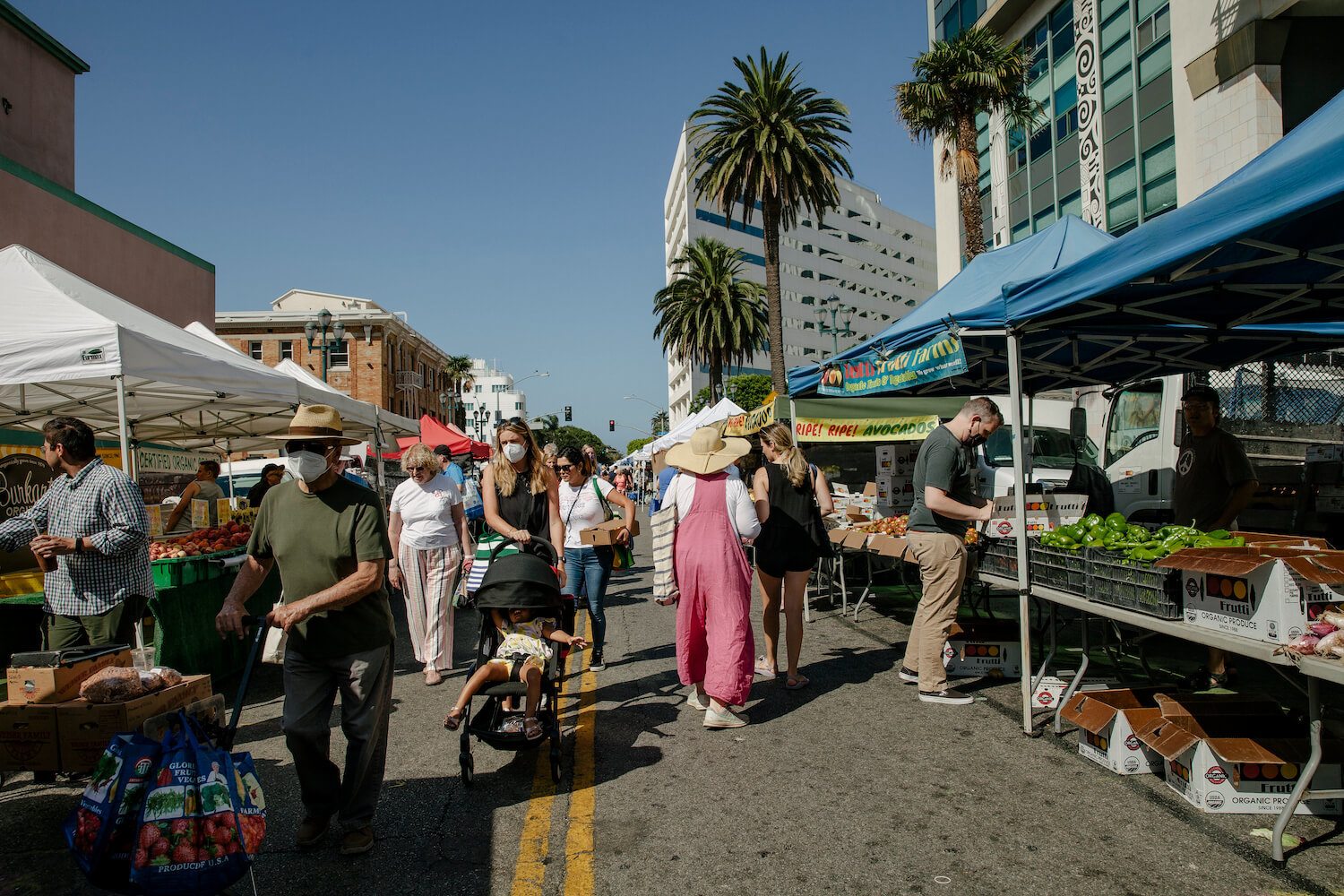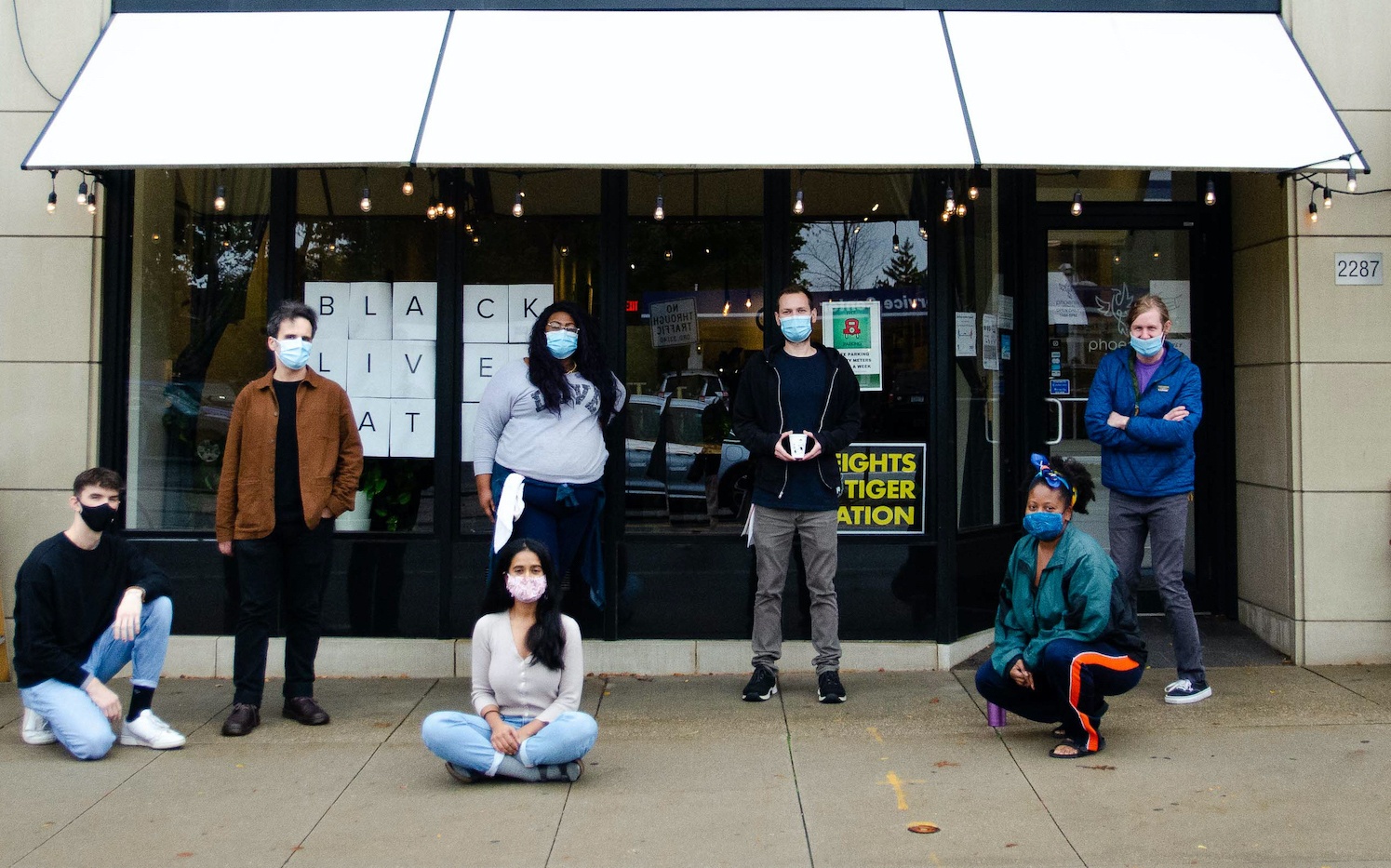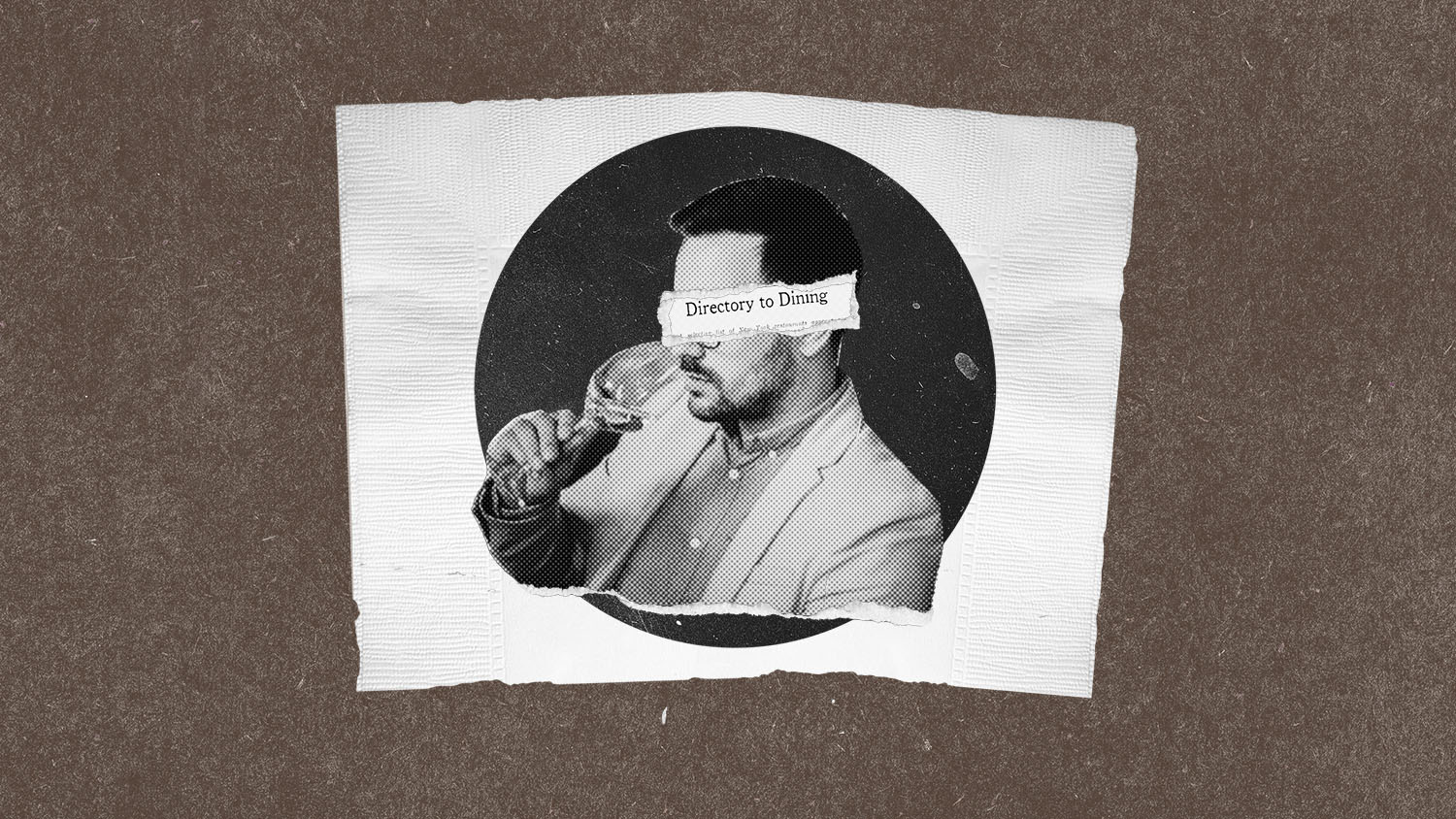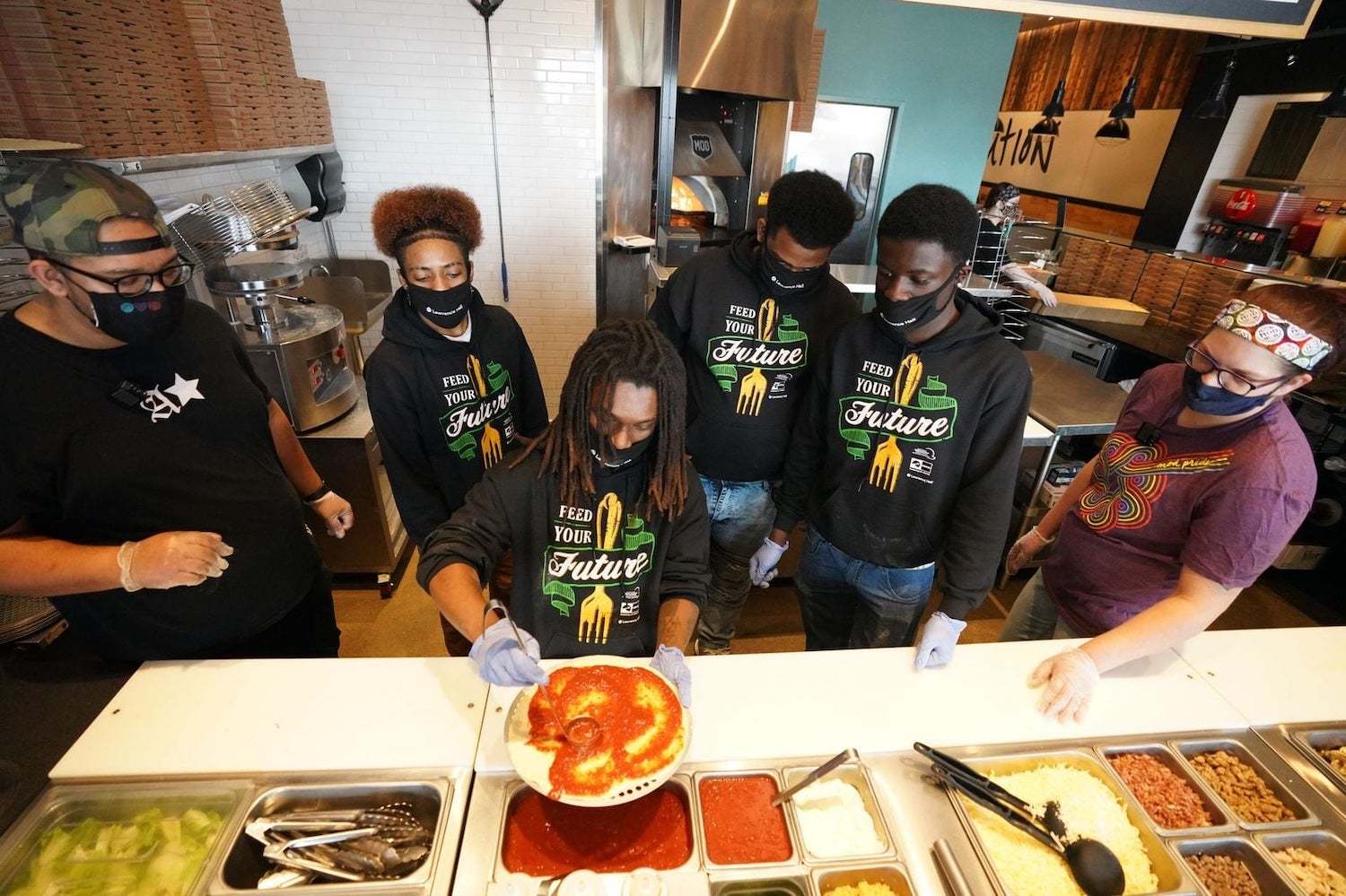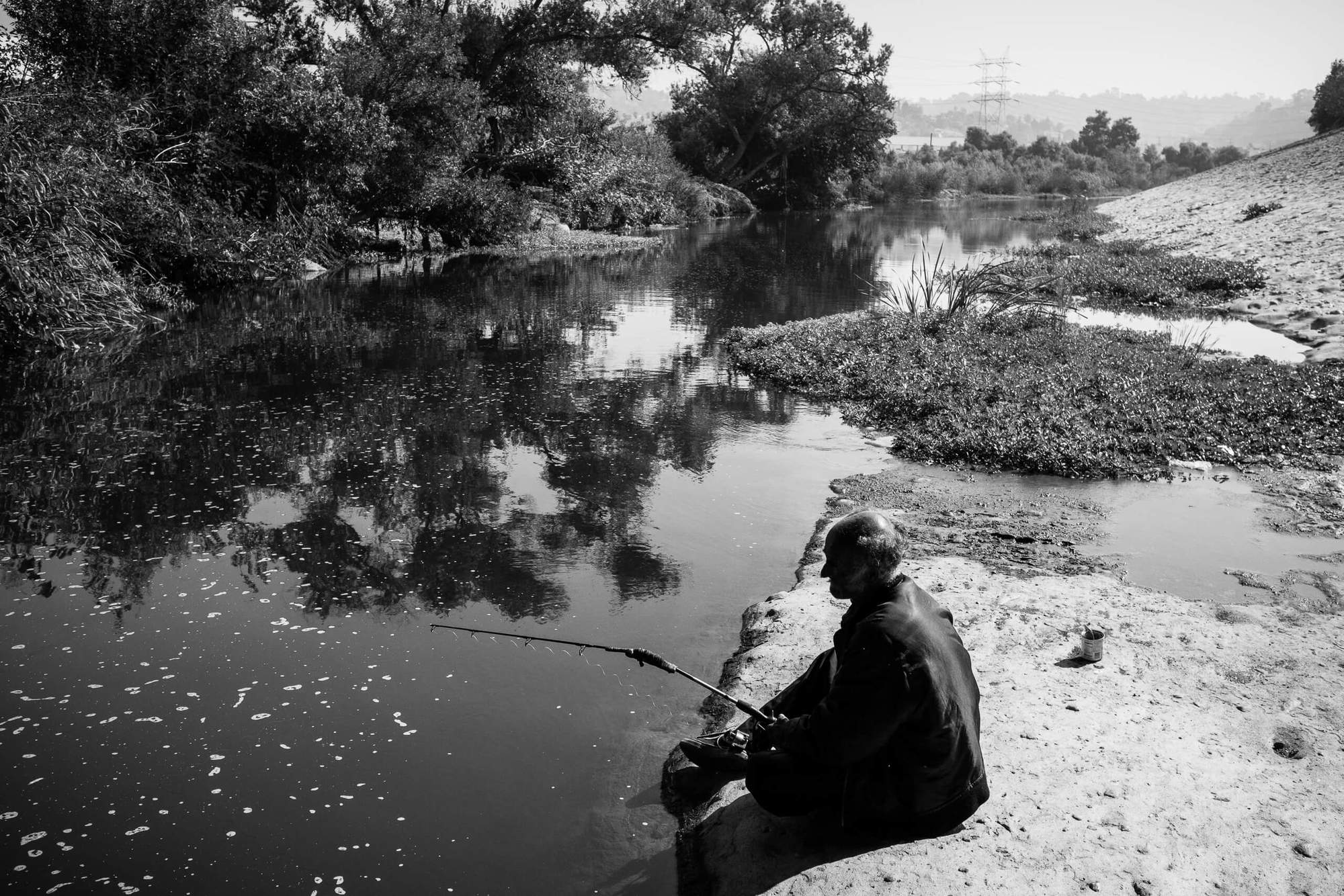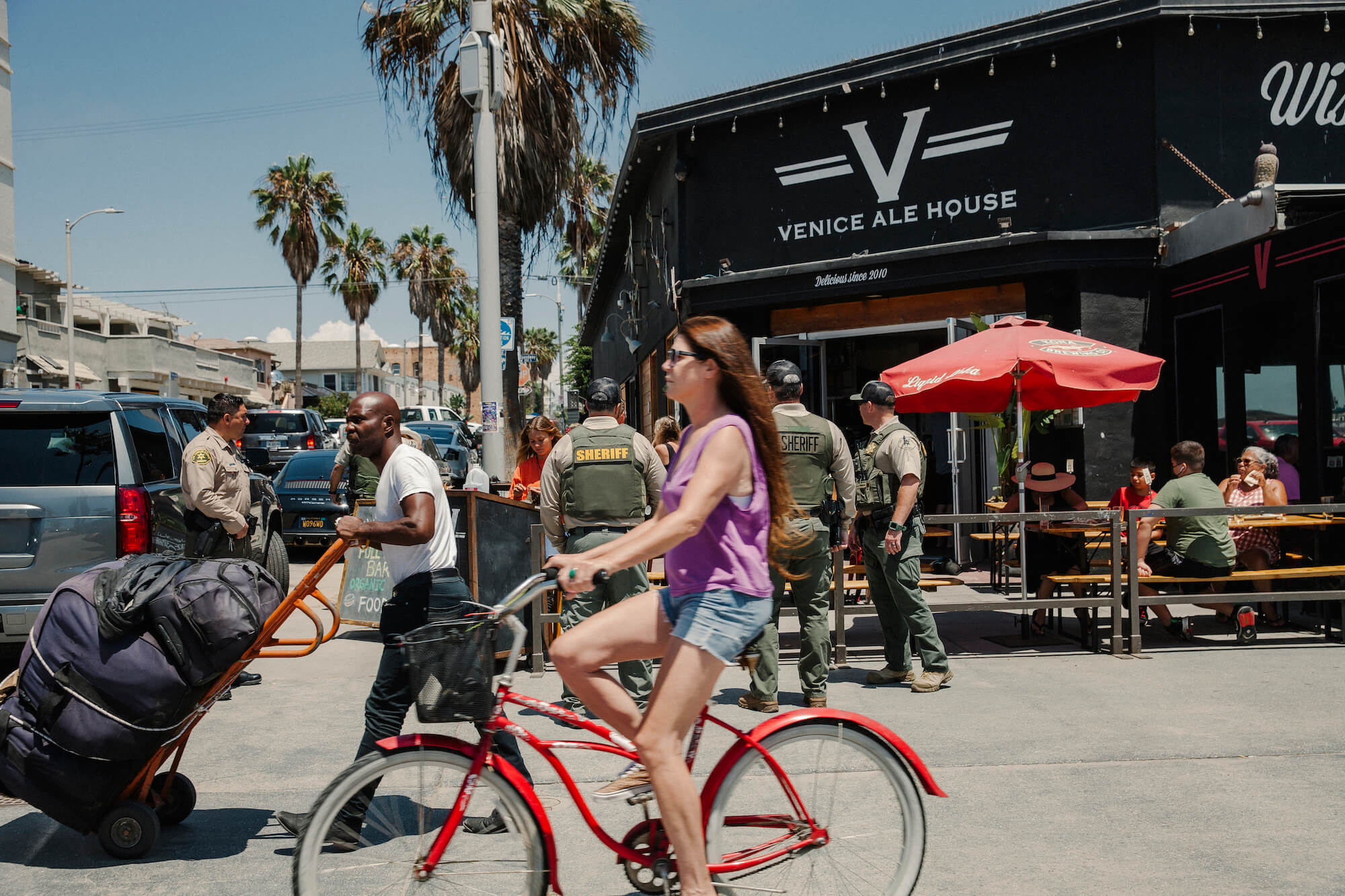
Samanta Helou Hernandez
For decades, Rose Avenue has been a symbol of Venice: unique, edgy, diverse, and unpredictable. Longtime locals, restaurants, tech-boom newcomers, and a large unhoused population all call Rose Avenue home, but there’s no consensus on how to fix the street’s growing homelessness crisis—and preserve its culture and sense of community.
Jason Neroni lives on Rose Avenue, though his house is 10 minutes away. The chef and managing partner at The Rose Venice, a bustling 375-seat restaurant two blocks from the Pacific Ocean in Los Angeles, spends more waking hours there than he does at home with his wife and two children: weekends, late nights, holidays, usually from 11 in the morning to 11 at night. When he isn’t at the restaurant, he is as close as a text or a call.
Linda lives across the street from him, but again, not in the way you might think. Her home is in plain view from a table on the Rose’s front patio, and most days she’s outside, tidying up—sweeping the sidewalk in front of her two tents, sorting through the large bag that stands in for a kitchen pantry when ants invade her food supply one morning, her graying hair tucked under a scarf. She feels safer here than in the apartment she left six months earlier, though not safe enough to tell me her last name, which is why I have changed her first. People, she said, are looking to do her harm.
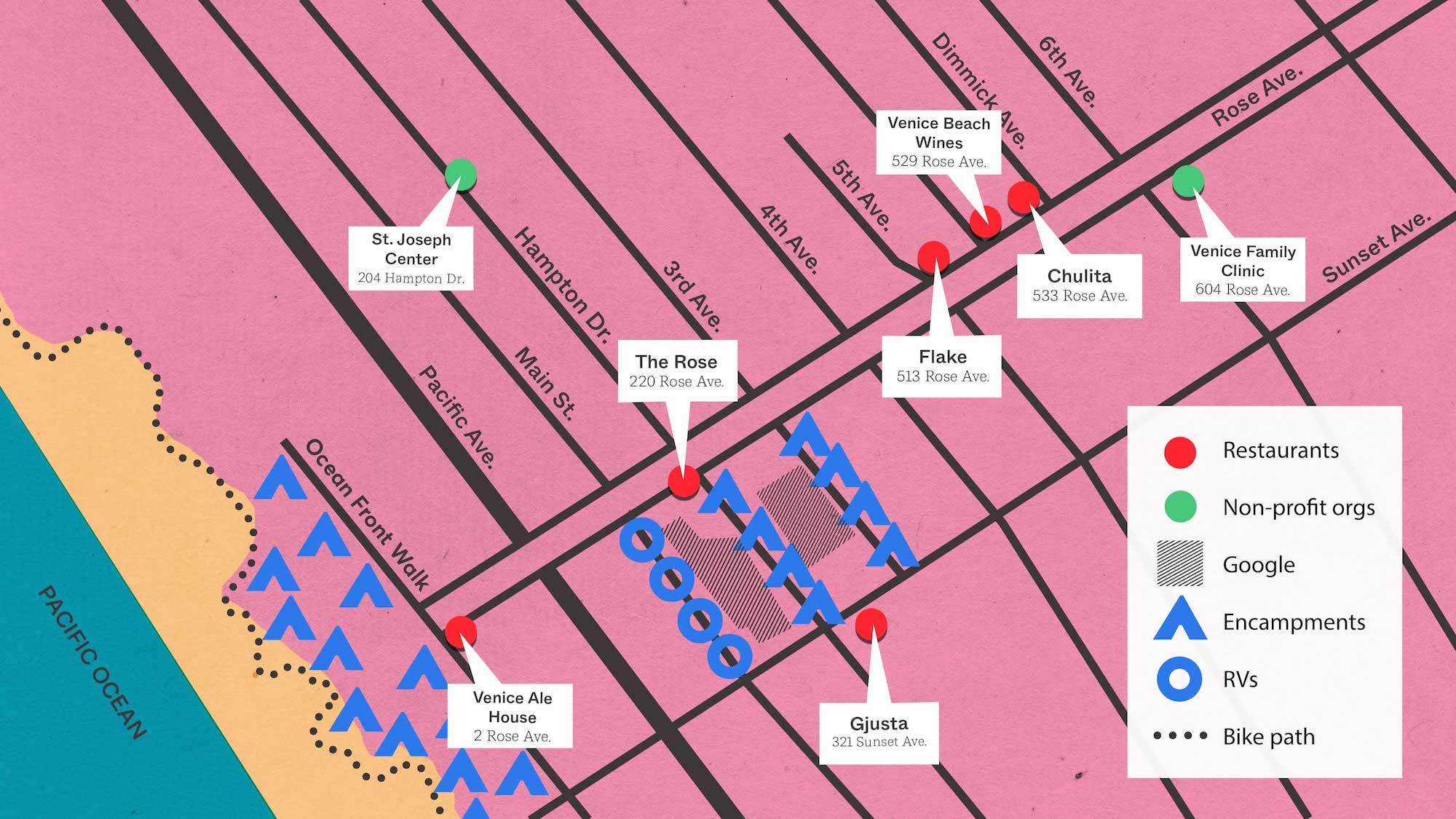
Rose Avenue’s business district runs a mile to the Pacific Ocean, and when summer began restaurants shared the space with an unhoused population that had grown dramatically during the pandemic.
Lacey Browne
Their other neighbor is Google, whose 100,000-square-foot campus wraps the Rose in a lopsided, understated embrace; there is no big identifying sign on the buildings, but the guards pedaling around the immediate neighborhood wear windbreakers that read “Google Security” on the back. The buildings were full of Google employees until the pandemic emptied them out, and will be, again, but the sidewalks belong to people who live in encampments, like Linda.
Linda lived at Rose Avenue and Hampton Drive at the start of the summer, right in front of Google, at the northernmost end of a block-long encampment that spilled into the Gold’s Gym parking lot at the other end. Hampton, in turn, was part of a larger grid that framed Rose Avenue from Ocean Front Walk, the popular beachfront boardwalk, east to Lincoln Boulevard, where the almost mile-long business district ends. Over 200 tents lined the edge of the sand along the bike path, and still more people lived on the boardwalk itself, on benches, in cupolas, and along the low wall that separates the boardwalk from beach parking. Two rows of permanently parked campers and motorhomes occupied Main Street, two blocks inland, and Linda’s street came next, with a larger encampment one block up, on Third Avenue. Another row of vehicles going nowhere sat on Rose at Lincoln, next to the Whole Foods parking lot. There were an estimated 1,900 unhoused people living in Venice, and Rose Avenue was the nexus of that community.
People experiencing homelessness have settled in Venice for decades, in part because nobody was going to roust them, which was part of the neighborhood ethos.
I live four blocks from Rose Avenue. Since last May, when I started to work on this story, I’ve bicycled up and down Rose and the surrounding blocks, to see how the street behaved, and who came and went. I’ve lived within a half-mile of here for most of my adult life; I’ve marked time for many years by what happens on Rose Avenue.
The current scene is nothing new and utterly different. Independent restaurants have staked out Rose Avenue as their home, and have been part of the community in the way that a franchise outlet or chain cannot, essential to the street’s personality. Longtime local residents were drawn to the neighborhood for the same reason—for the non-franchise experience—and were loyal to the restaurants that shared their point of view. Over time, a community grew up around places that felt like incarnations of the street’s soul. A pervasive live-and-let-live attitude verged on an imperative, as residents and businesses who wanted a broader range of experience accepted the fact that it might not all be easy fun. People experiencing homelessness have settled in Venice for decades, in part because nobody was going to roust them, which was part of the neighborhood ethos. Life went on, and part of it happened in restaurants, where regulars bumped into other regulars, and an unhoused person might pick up a job or a free meal.
It’s not like that anymore. Restaurateurs were on thin ice even before the pandemic, and the smart ones proceeded cautiously. Many didn’t have the time to grab a cheap lease on an empty block and wait for it to catch up, but they also couldn’t afford a more established, high-traffic location. They looked instead for the middle ground, a street with enough potential customers to make economic sense, but not so settled as to be out of their fiscal league. They looked for someplace like Rose Avenue.
Restaurants that had been on Rose for years, and survived the pandemic on fumes, had a right to be there, too.
It worked well enough until it didn’t, until the pandemic exaggerated every challenge the street had always faced, making everyone more vulnerable—the restaurants that gave Rose its public personality and were suddenly hanging by a thread, and the residents who lived there, whether in a standing residence or a portable one.
Neroni was more unnerved than someone with a smoother past might have been, because he had come close to the edge, himself: Ten years earlier he’d been in New York City when the funding for a new restaurant dried up, without warning, and suddenly he was an unemployed chef.
Expenses don’t wait for luck to change. Neroni envisioned his young family living in their car if he didn’t figure things out fast, until his grandparents in Garden Grove, California, made a high-stakes offer of temporary housing: All Neroni had to do was give up his New York dream, move his family in with them, and start over, at 35. By 2015 his life was back on track. He and a business partner took over the Rose, which in a single pre-pandemic year racked up 2 million covers, or individual checks, thanks to a heady combination of locals, the tech crowd looking for a clubhouse, and tourists.
No longer.
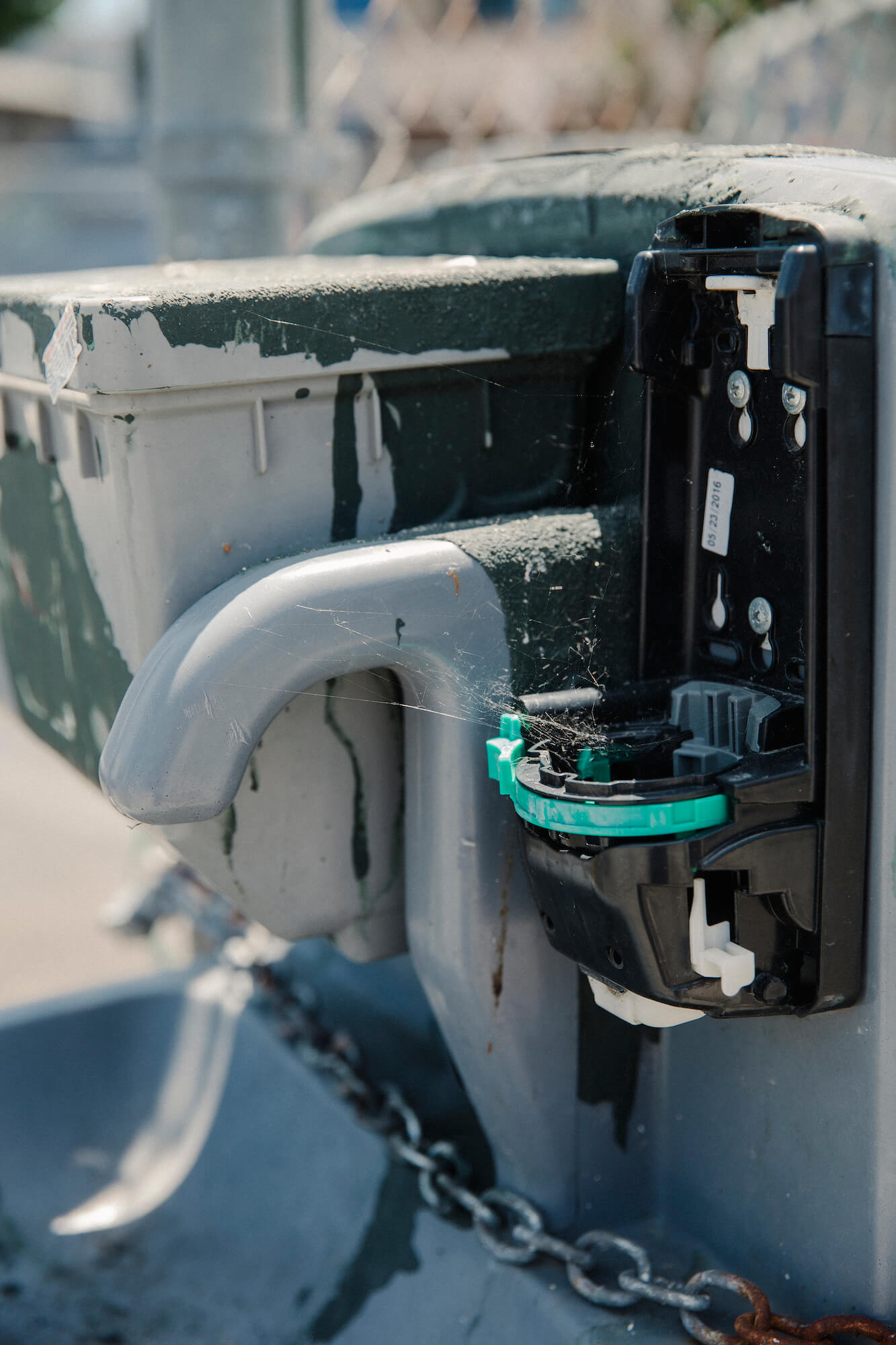
Samanta Helou Hernandez
Los Angeles set up portable washstands during the pandemic, but they ended up being used as trash receptacles.
—
Venice, a beachfront community annexed by Los Angeles in 1926, is the second most popular tourist destination in Southern California, after Disneyland, according to the city’s Parks Department, and Rose Avenue is its Main Street, promising food, shopping, and a late-day, sunset stroll that never gets stale. People who chase experience come to Rose Avenue, which has long resisted big-name corporate incursions, and congratulate themselves for appreciating its creative soul. People who want something more familiar go elsewhere. If there is an element of danger to it—and there always has been—Venetians do their best to skirt it, even to pride themselves for not getting rattled. Rose Avenue is authentic take-it-or-leave-it Venice, not a destination designed to cosset anyone.
Unhoused people have long gravitated to Venice, which has provided support services even as it enforced city practices that limited the ways in which people lived outside, but the pandemic changed everything. The hot-shower truck was unreliable, portable toilets were cleaned less often, and new portable wash stations became de facto trash receptacles.
There was a moratorium on weekly street cleanings and city ordinances that had required people to live in portable homes they could move when the sanitation workers and police arrived. Without that codified disruption, many people abandoned individual tents in favor of what locals referred to as “super-structures,” abodes constructed of tarps, tents, scavenged drywall, whatever it took to build out a home that spanned sidewalk to curb and gave people more space. Pedestrians had no choice but to walk down the middle of the street on Hampton Drive and Third Avenue. Both residents and restaurant people speculated on whether the dismantled bikes they saw were stolen and rebuilt to avoid easy identification, and assumed that the drug sales they used to see in plain view now transpired inside some of these structures. They shared rumored talk of prostitution and gangs. But the police were precluded from entering a tent without a warrant, by the same Fourth Amendment that protects residents of permanent housing.
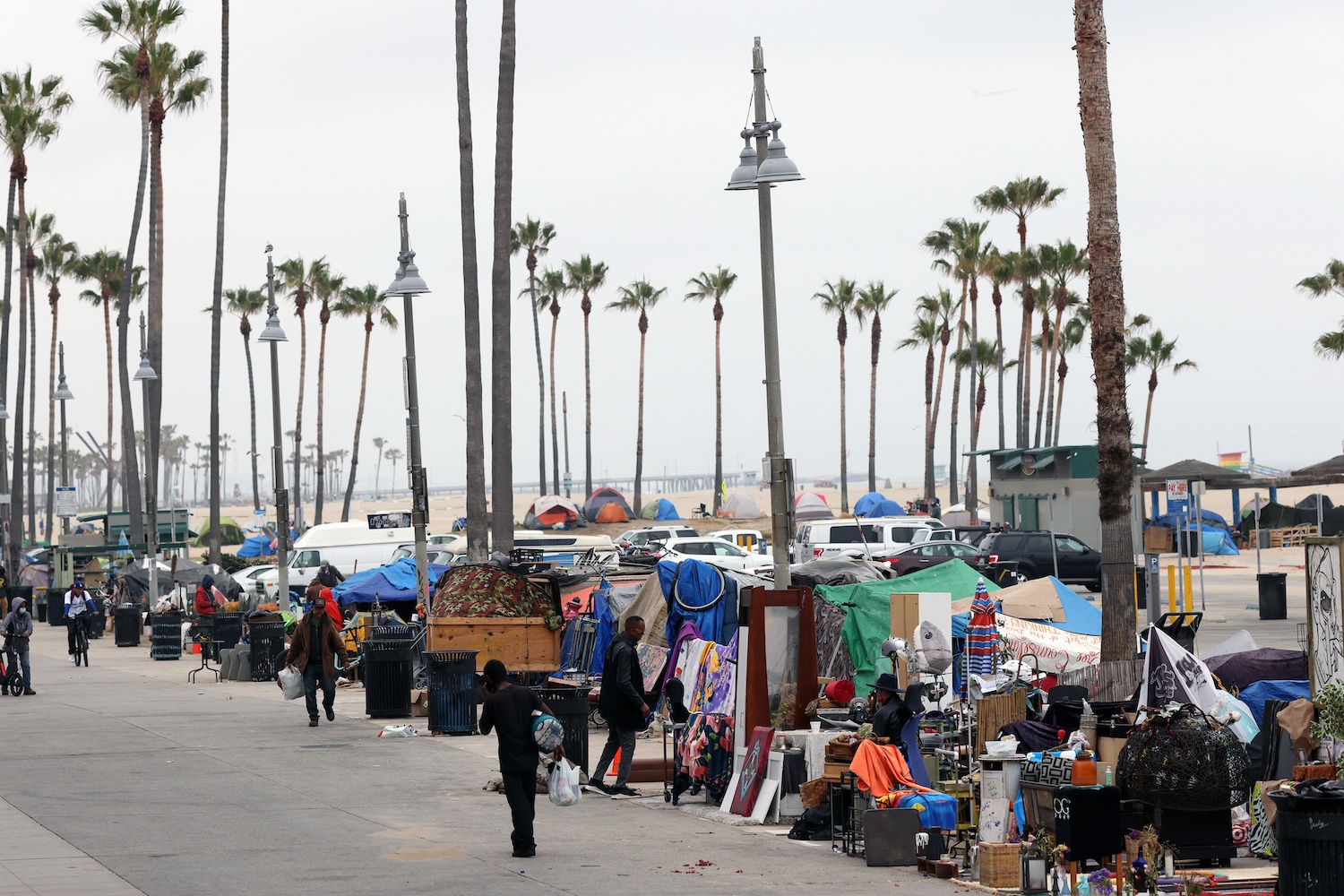
At the start of the summer, unhoused people lived along Ocean Front Walk, the Venice boardwalk, with hundreds more in a parallel line along the beachfront bike path.
The neighborhood had become a combustible mix of too much need and too few resources. Neroni began to keep an informal log of troubling incidents—security camera footage of arguments among people from the encampments, day and night, that spilled into the street or the Rose’s parking lot—and when he reached out to his restaurant neighbors on the street, he heard his own experience echoed back. As calls for help went unanswered, each restaurateur or manager or employee was left to figure out how to protect their co-workers and their customers. Neroni hired a private security firm and reimbursed employees out of pocket to replace their cars’ broken side-view mirrors.
He wished the city would do more to provide even temporary housing for his neighbors, but other than a hardly sufficient 30-unit building going up across from Whole Foods, he pinned his practical hopes on the return of city services. Not that he had any idea how it would work: When he stood outside and looked the length of Hampton Drive, he saw structures that were simply too big and cumbersome to move. It was a crisis in the making, after years of simmering conflict between the community on the sidewalk and local businesses and residents, because the city’s old methods of addressing the situation simply wouldn’t work anymore. Sanitation crews and the Los Angeles Police Department (LAPD) could tell people they had to move, but residents of these larger structures couldn’t comply without losing much of what they owned. Still, something had to happen, and soon. Restaurants that had been on Rose for years, and survived the pandemic on fumes, had a right to be there, too.
The street teetered now, off balance: People who work on Rose hope for some kind of intervention, while people who live on the street hope to be left alone.
On one Saturday night in May, the Rose’s private security guard defused an incident after a handful of calls to 911 went unanswered, and Neroni reached his breaking point. Venice’s reputation as an edgy, idiosyncratic place—“Bohemian” was the default adjective—was seductive only as long as it didn’t feel threatening, and Rose Avenue was starting to feel out of control even to the people once drawn to its unpredictability.
The security guard checked LAPD’s scanner and told Neroni that he could hear the calls coming in, but no one had responded.
“They’re never coming,” he remembered the guard telling him. “You’re on your own.”
—
Venice has inequity in its DNA: Developer Abbott Kinney, a chain-smoking asthmatic who made his fortune in tobacco and fell in love with Italy’s Venice, wanted to recreate it as a tourist mecca in Los Angeles. Venice of America, as he called it in 1905, offered visitors a replica of Venetian canals and buildings with Italianate arches, as well as piers, a roller rink, a dance hall—even an indoor heated salt-water pool, much of it built and staffed by Black employees who were installed in a square-mile neighborhood on the inland side of the electric car tracks and were prohibited from living closer to the beach. The resort, its white guests, and wealthy weekenders occupied the space west to the water.
It was an invention, that early Venice, and like any fiction was a mix of truth, lies, fantasy, and myth. As the story goes, a single surviving grid of canals—the others were filled and paved over starting in the late 1920s by a city in love with the automobile—exists only because a contractor was paid in advance, took the money and ran, and the city decided not to spend it twice.
The pandemic shutdown had turned Rose Avenue into a temporary ghost town, then a take-out corridor, and now, finally, a row of struggling businesses hoping to regain their feet during the summer season, always their busiest.
If the rest of the canals are gone, the economic extremes that created them are not. A man wealthy enough to create his own version of a beloved city—and to employ people who were dependent on their wages—had left Venice a gambler’s legacy, an affection for the unlikely idea. There’s more existential elbow room in Venice compared to coastal neighborhoods that developed along more traditional lines, more acceptance of someone who has a dream rather than a career path. But fewer limits can work both ways, a meteoric success or a crash and burn. The landing, if things don’t work out, can be a hard one.
There has been plenty of bad luck to tip the odds: In the 1970s, cutbacks on affordable and subsidized housing; in the 1980s, a broken promise of local mental health facilities that put people on the street without essential support services; a nationwide population boom in the 1990s that brought 4.1 million more people to California and turned Los Angeles’ already insufficient housing supply into a harsh game of musical chairs; the 2008 recession, which pried open the grasp of people barely clinging to stability. The only constant was the eternal lure of land near the beach, which attracted people who could afford outsized prices and made matters worse for everyone else.
The arrival of Google and Snapchat, in 2011 and 2012, respectively, brought the latest infusion of buyers’ money, as a new, young, wealthy crowd looked for places to live near the office. Snapchat decamped in 2017, but not before tech employees drove real estate prices even higher, tightening the rental market.
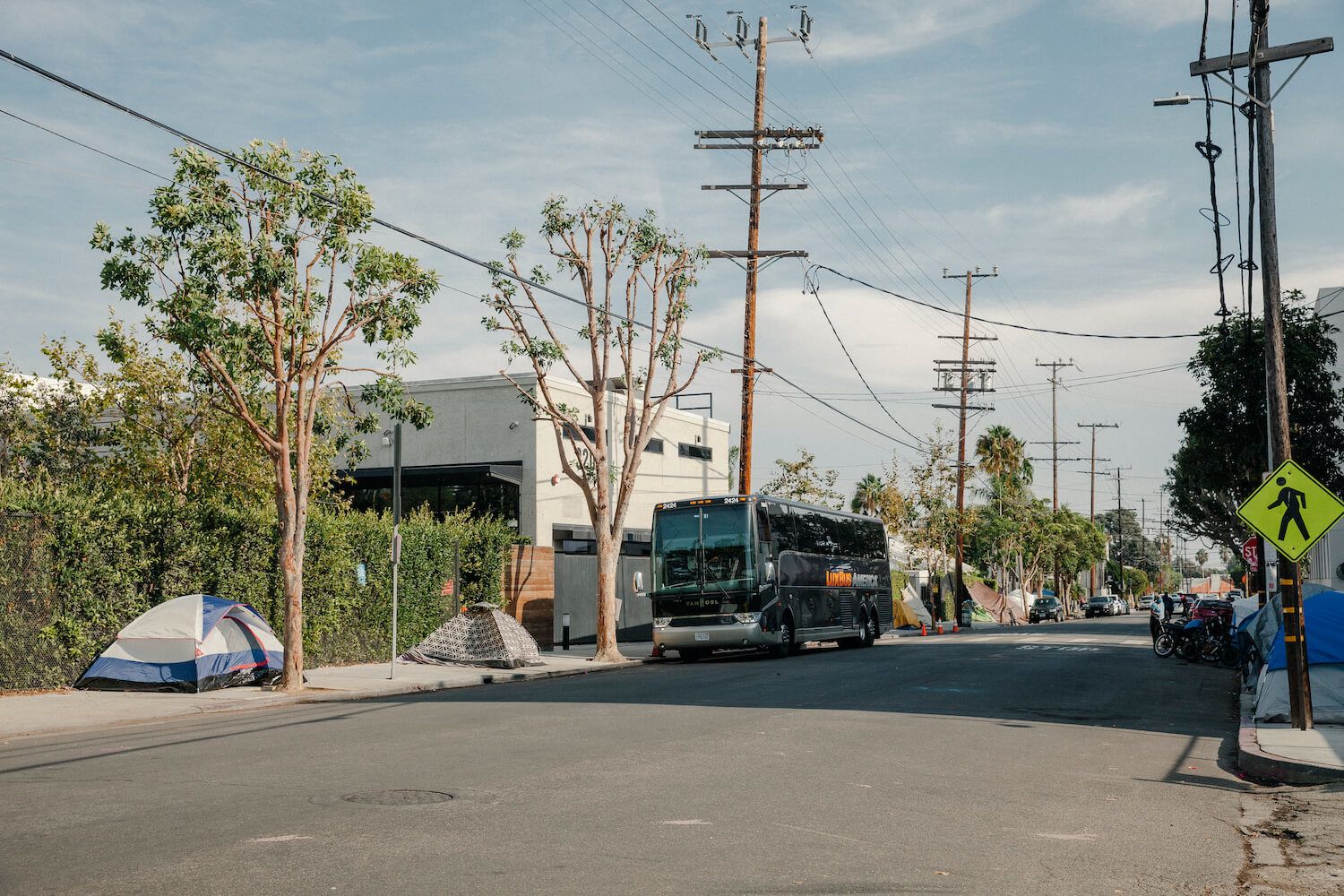
Google’s sprawling Venice campus runs parallel to the Hampton Drive encampment, and faces a double row of permanently-parked vehicles on Main Street.
Samanta Helou Hernandez
As early as 2013, a local realtor described Venice prices as “through the roof,” thanks not only to the two tech behemoths but also the smaller start-ups and tech incubators that trailed in their wake. Realtors have a code to describe the area’s appeal: “AWOL,” which means Always West of Lincoln. You can’t go wrong buying property there, even if $1 million is barely enough for a teardown.
Restaurants reflect and define their neighborhood, and for years the places on Rose had offered diners a good time that was unique to the street, at restaurants and shops they couldn’t find anywhere else. But the pendulum swung both ways, and an influx of discretionary income threatened to disrupt the street as much as Neroni’s growing list of incidents. Restaurateurs kept a wary eye on nearby Abbott Kinney Boulevard, dubbed “The coolest street in America” in 2012 by GQ magazine, which had resembled Rose Avenue until national and international brands started to shoulder independent businesses out of the way. Vestiges of the old street remained, the occasional local clothing shop or bar, but they were the exception that proved the rule. Abbott Kinney felt like a hipster Venetian version of Beverly Hills’ Rodeo Drive, which was not at all how Rose Avenue saw itself—and yet on a bustling Saturday night, when the new crowd hit both streets, it could be hard to tell the difference.
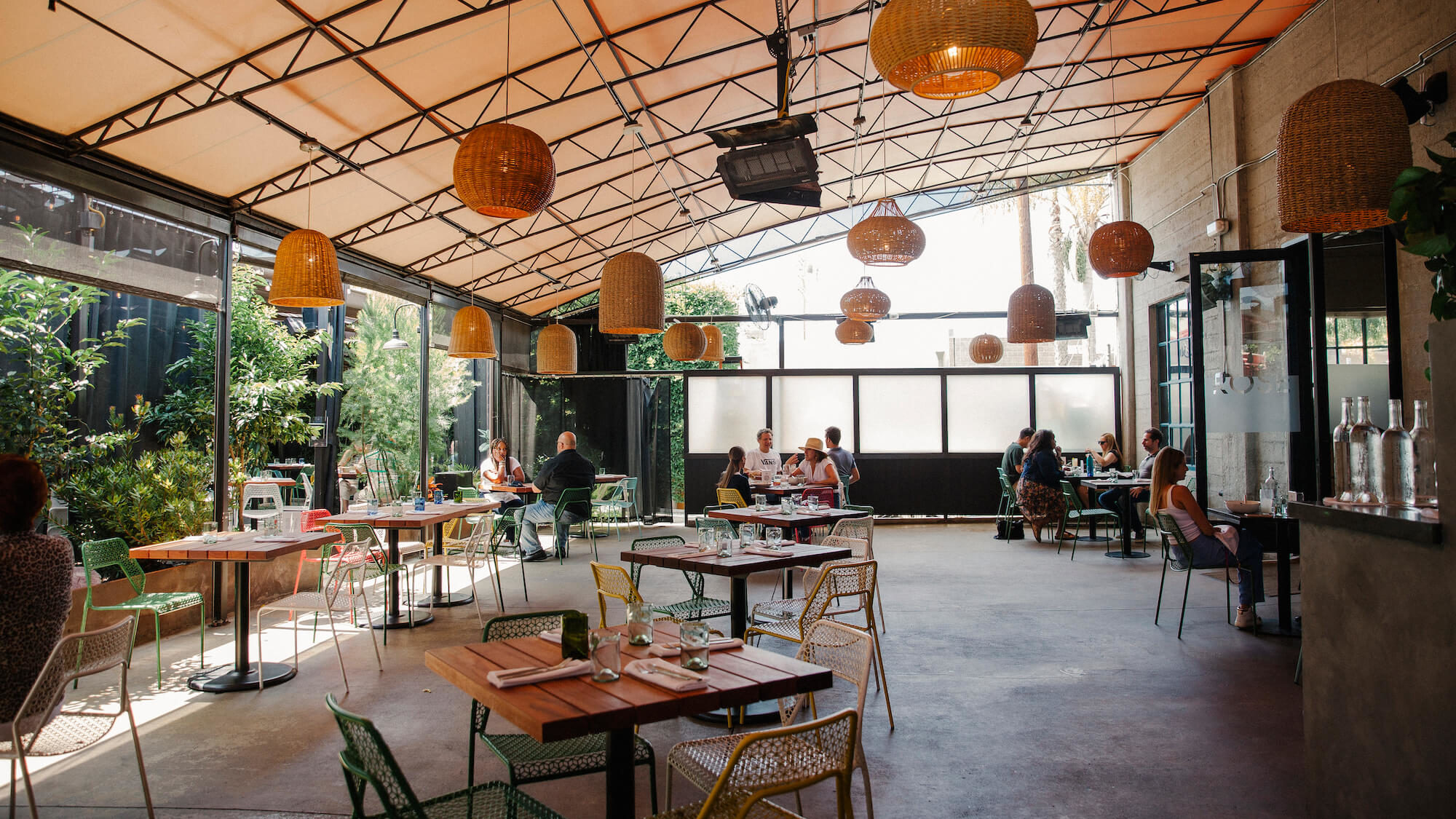
The Rose Venice is a local hangout, tech-crowd clubhouse, and tourist destination, sandwiched between a block-long homeless encampment and a row of permanently-parked campers and motorhomes.
Samanta Helou Hernandez
No place symbolized the tension more than the 42-year-old Rose Venice. It had unofficial landmark status, the avenue’s namesake, a big, bustling gateway to the Rose Avenue experience. On the other hand, you had to have money to eat there, and either enough audacity to think it was your right to do so, or enough history in the neighborhood to want to linger at a beloved, familiar spot.
The street teetered now, off balance: People who work on Rose hope for some kind of intervention, while people who live on the street hope to be left alone. LAPD senior lead officer Adrian Acosta has worked in Venice on and off for 16 years, at one point as part of the gang unit that patrolled the area where Abbott Kinney’s employees once lived, so he’s seen more than one type of conflict during his tenure. His responsibilities now include Rose Avenue from Hampton Drive to Lincoln, and his appraisal is absolute: The vibe there has changed for the worse.
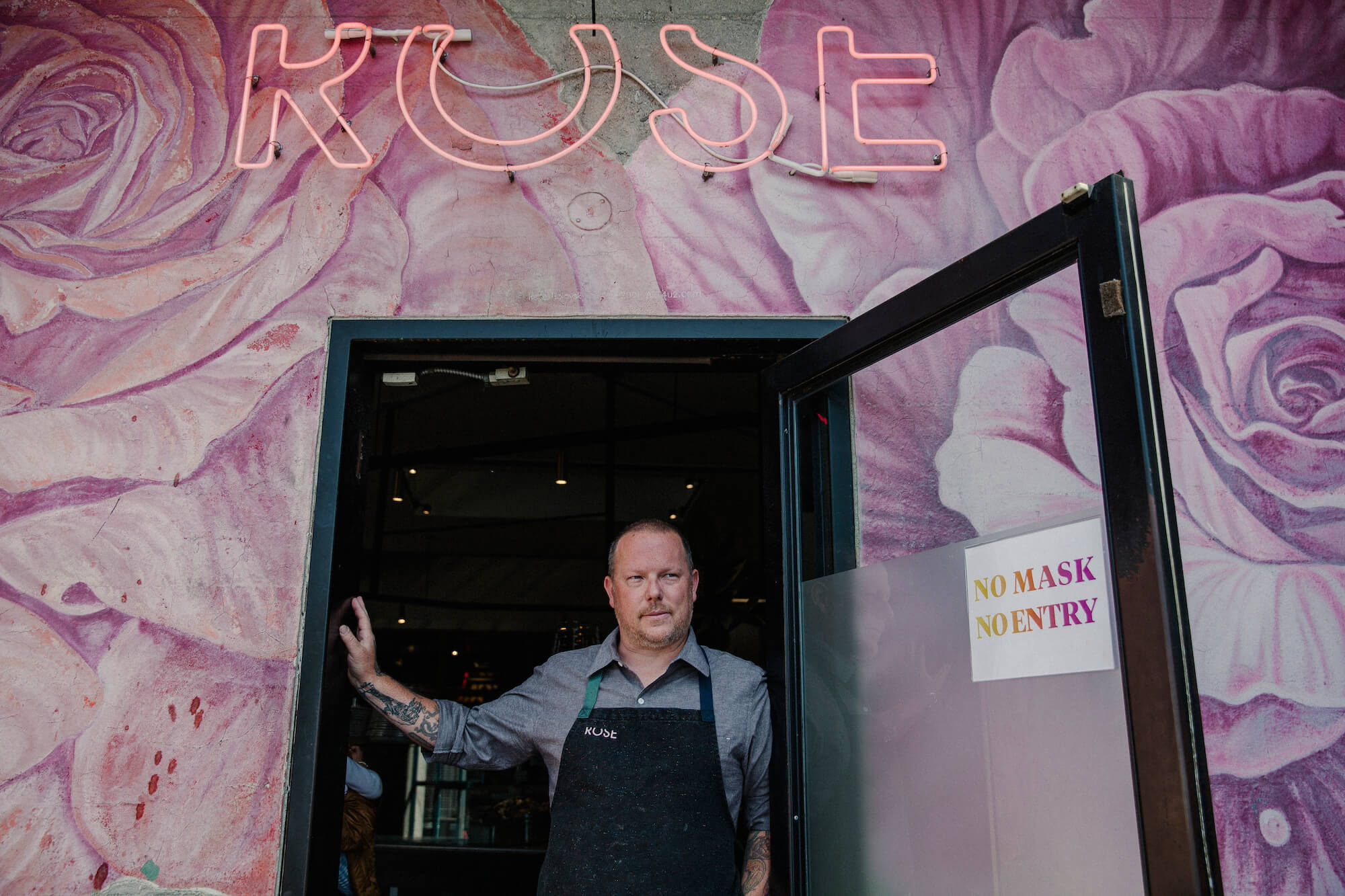
Jason Neroni, chef and managing partner at the Rose, emerged from the pandemic only to worry that customers wouldn’t feel safe enough to return to his restaurant.
Samanta Helou Hernandez
Neroni lost his patience, that Saturday night in May, because of a 6-foot guy waving an aluminum bat. The man first appeared at the corner, yelling at people and cars and waving his arms, just feet from where customers checked in at the Rose’s outdoor host stand. Neroni’s managers called 911, but by the time the chef got to the front door the man had disappeared.
When he returned moments later with the bat, the chef told his managers to call 911 again, as well as the private security service. He started to step forward, and stopped. “He swings that bat right,” thought Neroni, “and I’m paralyzed.” To his relief, the armed security guard showed up, and his official-looking uniform was enough to discourage the man with the bat, who dropped it and wandered off down Hampton Drive. The police didn’t respond to the second set of calls, either, which was when the guard explained that they never would.
Neroni was tired of feeling ignored, tired of feeling like the street’s problems were the street’s to solve. He sent an email to his city councilman, Mike Bonin, a strong advocate for the rights of the unhoused and a target of increasing ire from an impatient wing of local residents and business owners who wanted action.
“I am writing to personally invite you to the Rose to sit down and have a cup of coffee with me,” he wrote. “I would love the opportunity. . . to show you my home (The Rose), meet some of my family (our staff), and share with you our experience over the past year.”
The pandemic shutdown had turned Rose Avenue into a temporary ghost town, then a take-out corridor, and now, finally, a row of struggling businesses hoping to regain their feet during the summer season, always their busiest. Neroni intended to pursue his councilman until he and his restaurant neighbors got the attention he thought they deserved.
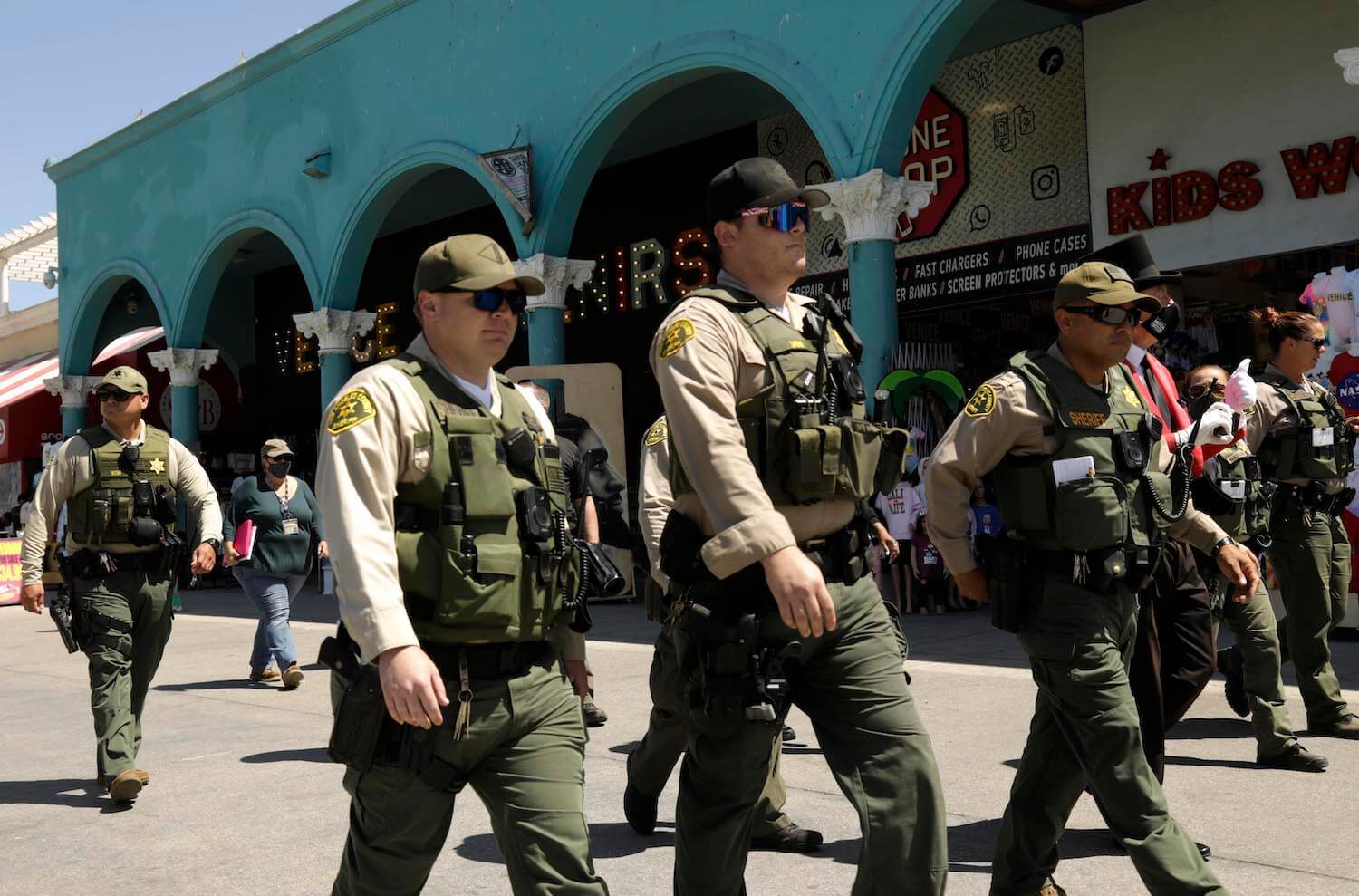
The County Sheriff, Alex Villanueva, announced an aggressive plan to clear out the boardwalk, including the possibility of arrest, in time for the July Fourth weekend.
Genaro Molina / Los Angeles Times via Getty ImagesBut the councilman and the county sheriff, Alex Villanueva, were entangled in a turf war, sparring over who had jurisdiction over the beachfront boardwalk encampments and what approach to take, with Bonin talking about compassion and patience, and Villanueva talking about lawbreakers and the need to give public land back to the public.
The sheriff staked his claim first, appearing on June 9 in front of Venice Ale House, where Rose dead-ended into the Ocean Front Walk, to announce that the area would be clean by the July Fourth weekend, that living on the street was illegal, and that arrests were not out of the question. The next day Councilman Bonin announced the $5 million Encampment to Home program, which would provide immediate funds to secure temporary homes for Venice’s unhoused population. He, too, would oversee a boardwalk clean-up, but without arrests.
Five days later, on June 15, Bonin was served with a recall notice, the second time constituents had attempted to remove him from office.
—
Venice Ale House owner Thomas Elliott has lived six blocks from the corner of Rose and the boardwalk since 1997. He was here for the boardwalk’s heyday, the “party era” when marijuana and alcohol were the drugs of choice, and the people who lived on the boardwalk and at the beach were too few in number to form an encampment like the one he saw outside the Ale House at the start of summer.
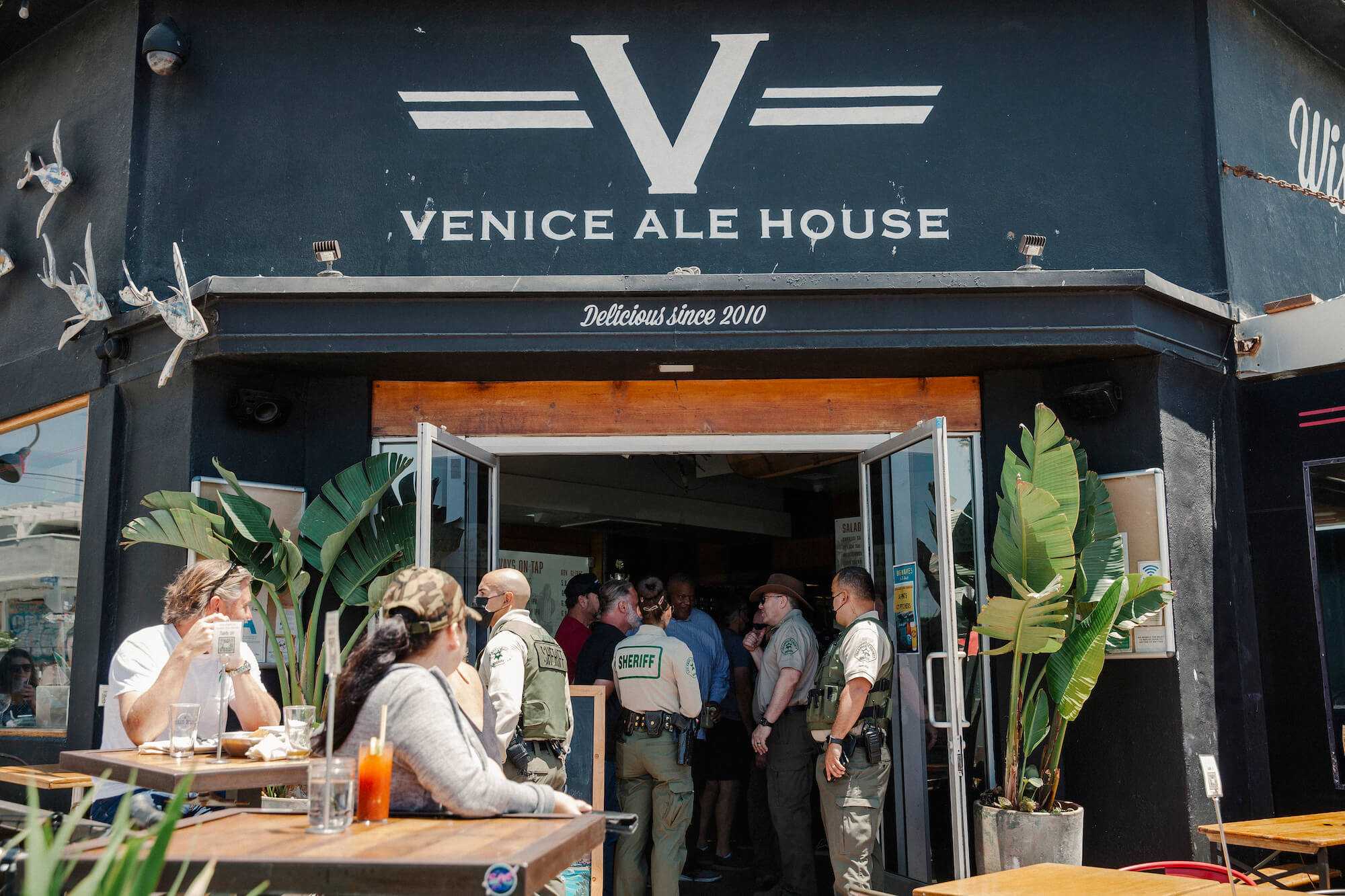
Venice Ale House owner Tom Elliott called the situation on Rose Avenue “a humanitarian crisis, no different from any refugee crisis.”
Samanta Helou Hernandez
Elliott knows exactly when the current spike began—the night in March 2020, when Los Angeles restaurants shut down for the pandemic—because he watched it begin, from home, on the restaurant’s security camera footage. “It started raining, and I was so afraid we were going to be broken into,” he said, “so I’m watching the cameras, and I saw this sad, sad guy, all drenched, pull his cardboard and blanket and tarp under our awning, and what am I going to do, roust him? Of course not.”
The next day, Elliott watched as a woman dragged her folding chair under the Ale House’s awning, followed days later by a man in a wheelchair. “They lived there,” he said. “We had an outlet out there so they pulled in their cell phones and built a canopy.” They stayed until the city allowed restaurants to re-open for take-out, two months later, at which point Elliott approached the trio and asked them, “politely,” he stressed, to move.
“There are no boundaries. It’s a humanitarian crisis, no different from any refugee crisis.”
As the encampments across the boardwalk and on the low hill by the bike path continued to grow, Elliott saw a different type of drug user than he’d seen in the 1990s —less mellow, more addled and aggressive, likelier to have turned to methamphetamine and fentanyl, which were cheap and easy to find.
“Every day there’s someone outside panhandling,” he said. “Or a customer comes in to ask, ‘Can I have another sandwich?’ A woman just walked by and grabbed the sandwich off his plate. People walk by and grab drinks off tables. I used to be [able to] police my own restaurant, but I’m not enough. And we’re definitely losing business.”
His security guard had instructions to intervene if anyone breached the invisible perimeter of the outdoor seating in front of and alongside the building. Elliott said it happened almost every evening.
Elliott doesn’t hold his neighbors responsible for what’s going on; he blames the city for what he said is both a housing and a public health crisis. “People do what they’re allowed to do,” he said. “There are no boundaries. It’s a humanitarian crisis,” he said, “no different from any refugee crisis.”
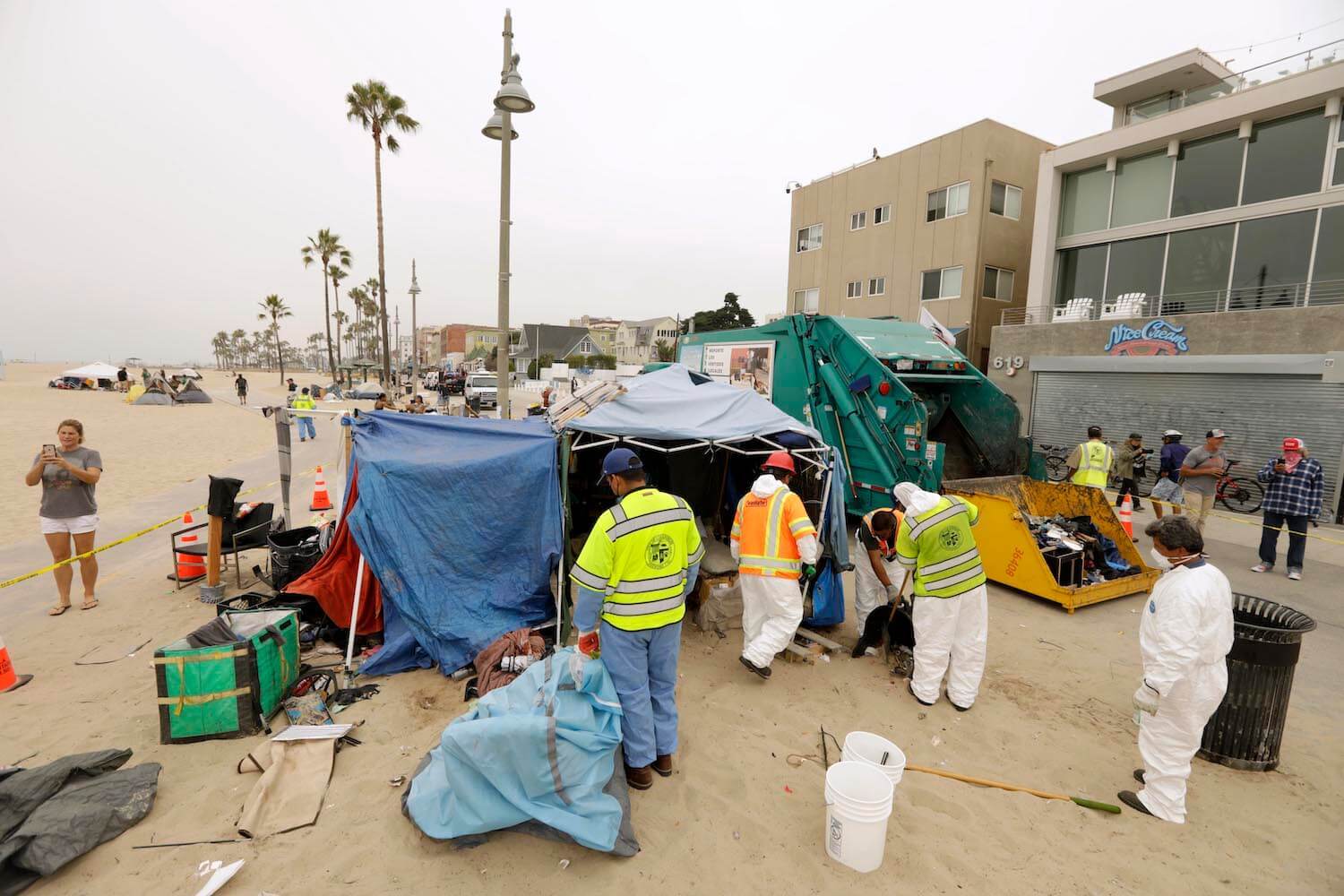
City sanitation workers began a boardwalk clean-up in late June, as representatives of St. Joseph, a local nonprofit, arranged temporary housing for people willing to take it.
The city beat the county to the boardwalk with a clean-up and rehousing effort that began on June 28 and worked its way north, landing in front of Venice Ale House on the morning of July 13. It was a two-step process: People had to decide what they wanted to carry with them or put into temporary storage, while anything else would be thrown away, and then they were provided with transportation to temporary new homes. The crowd that gathered to facilitate the effort included a city sanitation crew, LAPD officers, and representatives of the nonprofit St. Joseph Center.
Marce de Thouars has worked for the sanitation department since 2013, usually on the city’s downtown Skid Row. He said he has learned two things: People who live on the street regard him as “the enemy,” so it was important to avoid confrontation, and even a peaceful process is no guarantee of lasting success.
“There are different agencies out here trying to help people get back on track,” said de Thouars, “but it’s very hard, because the big majority suffers from addiction, whether it’s alcohol, drugs, you name it. They aren’t bad people. They’re just out of luck.”
Francisco believes Rose Avenue is doomed, not because of the increase in the unhoused population but because of a pervasive corruption that depends on Venice for everything from lucrative real estate deals to nonprofit payrolls.
Helping them was someone else’s responsibility. His job, as he saw it, was to keep public spaces clean, which the boardwalk and the tents across the parking lot were not. The area might not have been pristine before the recent increase in tents, but the sheer number of people now guaranteed an increase in public health issues.
At the center of it all, as de Thouars and his coworkers waited, a white-bearded man sorted through a shopping cart full of his belongings, dividing them into three sets—what he would take with him, what he wanted the city to pack into a storage bin, and what he was willing to consign to the trash. It was a slow process, its logic known only to him. He considered two bottles of water for a long moment before deciding which one to place with his traveling possessions and which one to hand to a sanitation worker.
Nobody rushed him. In fact, people barely spoke. For a good half hour they waited, made small overtures, backed off, and waited some more. The man with the beard was going to sleep somewhere new tonight, and the transition would be on his terms, at his pace.
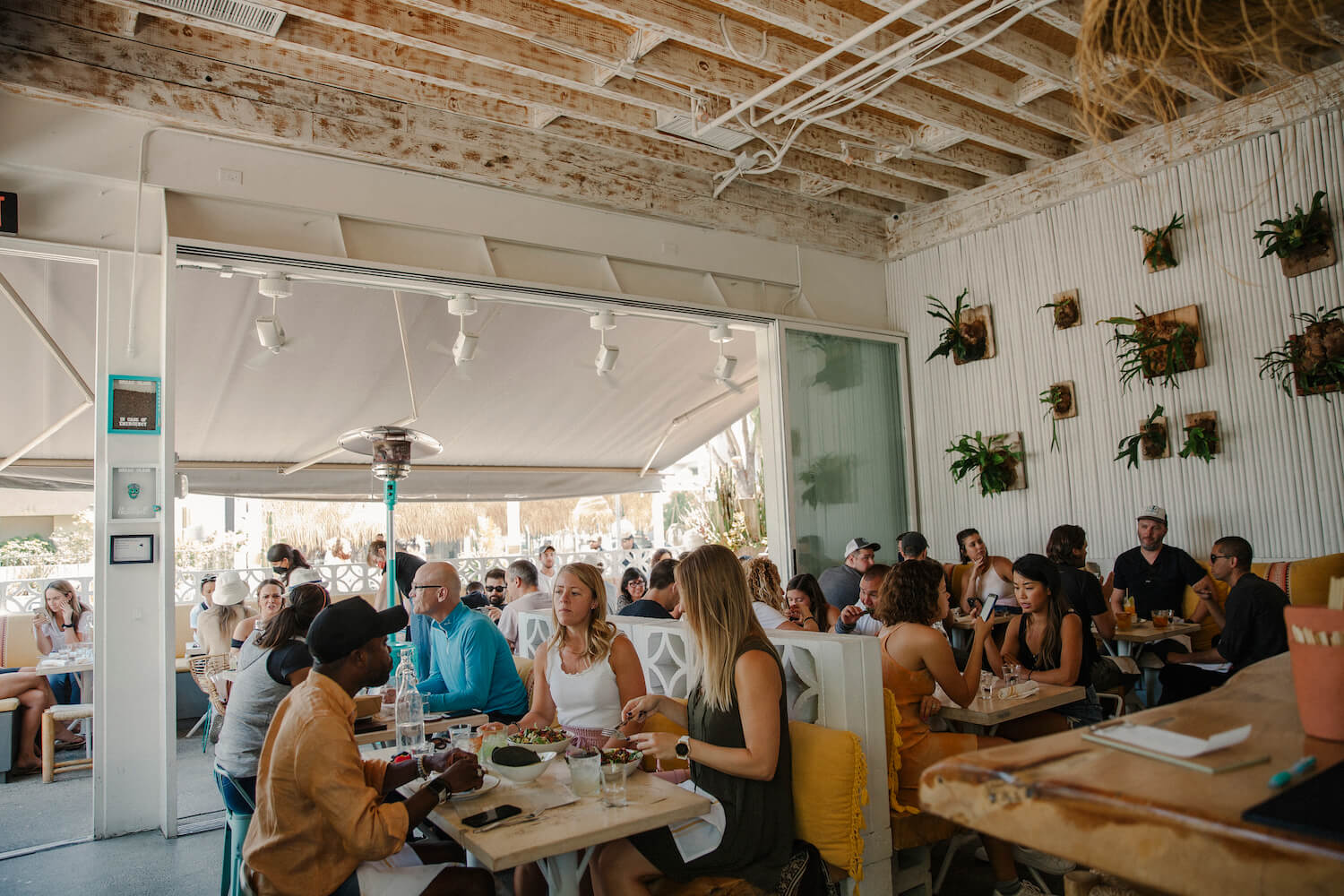
Chulita sat on a corner at one end of a block-long group of restaurants, and operations manager Tony Gutierrez was its self-appointed guardian—if trouble was coming, he usually saw it first.
Samanta Helou Hernandez
George Francisco was not impressed by the effort, but then, George Francisco has more than had it. The president of the Venice Chamber of Commerce is the Cassandra of Rose Avenue, certain that his prophecies are true and equally sure that no one wants to hear them. Francisco wouldn’t win any popularity contests in Venice on a good day—an adamantly independent voter in a liberal Democratic enclave, a cynic about bureaucracy whether it’s governmental or nonprofit, a villain in certain quarters simply because he represents the area’s business interests. It gives him a kind of freedom; he uses words like a match to kindling, and is proud of it.
What he has to say is hard to take. Francisco believes Rose Avenue is doomed, not because of the increase in the unhoused population but because of a pervasive corruption that depends on Venice for everything from lucrative real estate deals to nonprofit payrolls. To hear Francisco tell it, corruption in Los Angeles makes corruption in his home city of Chicago seem like small potatoes.
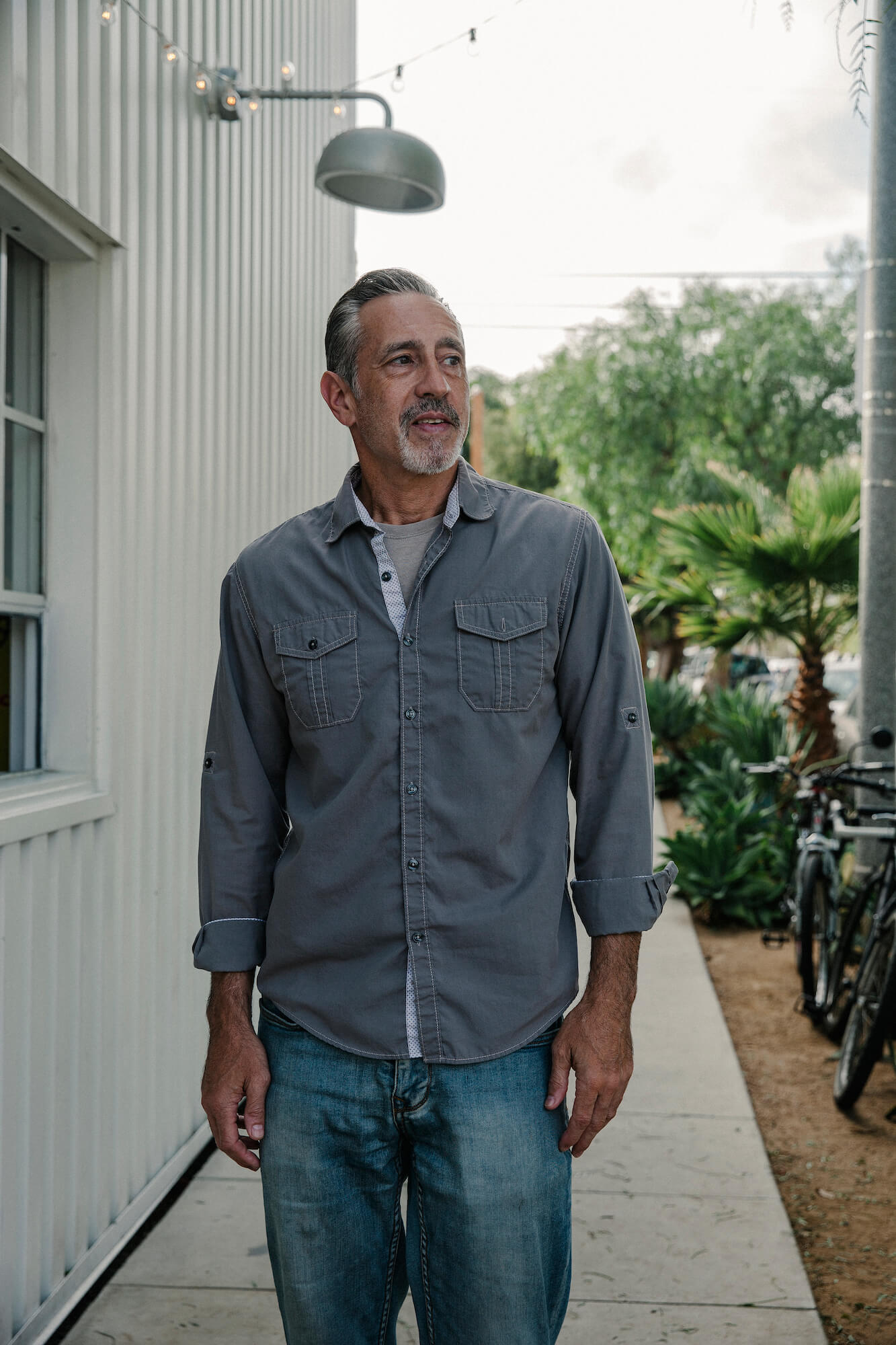
George Francisco, president of the Venice Chamber of Commerce, is heartbroken and angry over what Rose Avenue could have been and isn’t, and he has a list of officials and residents who have let the neighborhood down.
Samanta Helou Hernandez
He is not an armchair critic: Francisco has spent six years as president of the Chamber of Commerce, nine years as a member, seven years on the Venice Neighborhood Council, the last five as vice-president, and has participated in programs designed to improve communications between the community and law enforcement. But no one likes to hear that hope is gone, so he’s lost traction, over time—which has hardly shut him up.
He blames the city planners who ignored Venice’s original design and made it difficult to own a business or live there, with prohibitive parking requirements and residential zoning that limited housing, and accuses powerful people of letting their personal agendas eclipse what was best for the area. He blames city council people past and present, city government in general, homeowners with generational wealth who opposed the greater housing density that would get some people off the streets, and what he and others, including the county sheriff, refer to as the “housing-industrial complex,” the large nonprofits whose administrators, to Francisco’s way of thinking, would be out of their six-figure jobs if unhoused people found permanent homes.
He nursed a vision of Venice, and of Rose Avenue, specifically, that was probably extinct, or at least in its death throes, and he hated what was happening—or more to the point, not happening—because it wasn’t supposed to be this way.
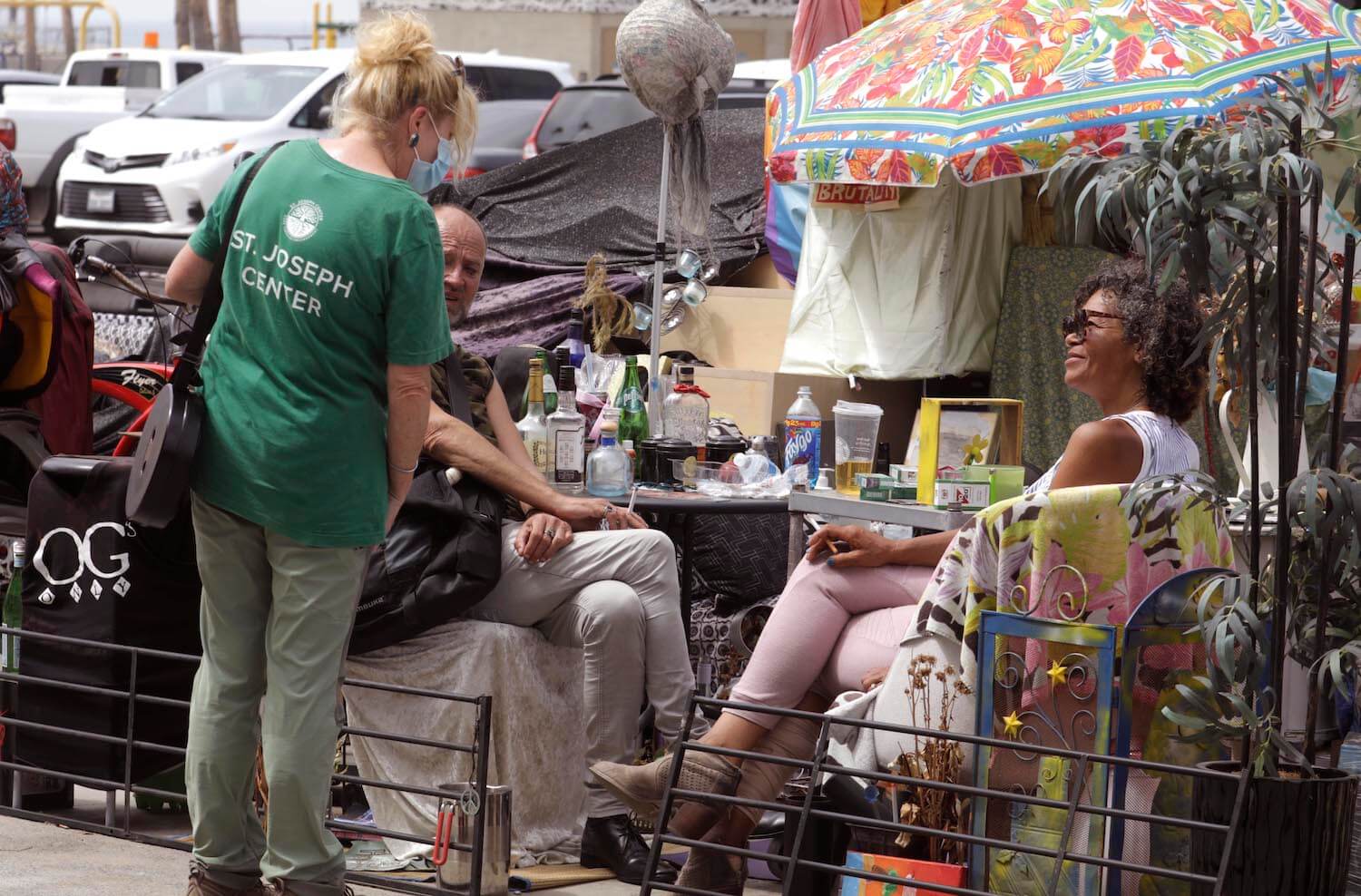
The nonprofit St. Joseph Center played a major role in the boardwalk clean-up, placing people in temporary housing and offering services to people who chose to stay.
Dr. Va Lecia Adams Kellum, president of the St. Joseph Center, had heard the criticisms, not only from Francisco but from the county sheriff, who of late had pinpointed nonprofit salaries as a waste of money. She did not take the bait, because comments like that only betrayed a lack of understanding of what her agency was trying to do.
St. Joseph’s slogan, “Hope Through Empowerment,” conveyed its four-part mission—to provide poor and unhoused populations with the resources they needed to become self-sufficient, through a combination of outreach, housing services, mental health care and educational and vocational programs. The center, founded in 1976 in a small Rose Avenue storefront, was now a citywide service organization whose main site was a large building on a quieter stretch of Hampton Drive. It had been brought in to facilitate the boardwalk cleanup, which Kellum pronounced a resounding success: 213 people were moved off the boardwalk, most of them into temporary housing, because finding apartments for the ones who received subsidies for permanent housing could take another six months. St. Joseph representatives “engaged” with many more people who chose not to accept housing, she said, to let them know about other available medical and mental health services. An impatient critic might see the glass as half empty, because some of the beachfront population was still on the street, and people might circle back to the neighborhood when temporary housing ran out. Dr. Kellum took a longer view: Rehousing simply took longer than local residents—and restaurants—might like.
“We’re okay with being put out of a job if we can address the homeless situation. But homelessness and services go hand in hand, and when we get someone off the street our services have to continue. Our size is in keeping with the problem, with the urgency of keeping people alive.”
“Certainly the sheriff is entitled to his opinion,” said Kellum, “but we’re okay with being put out of a job if we can address the homeless situation. But homelessness and services go hand in hand, and when we get someone off the street our services have to continue. Our size is in keeping with the problem, with the urgency of keeping people alive.”
That involved treating a large population with mental health issues—an enormous challenge, according to Karen Lauterbach, director of community programs and advocacy at the Venice Family Clinic, “often because a symptom of their disease is thinking there is no problem.” Of the over 3,900 unhoused people the clinic saw between July 2020 and July 2021, Lauterbach said 45 percent had mental health issues—and if the ones on medication didn’t lose their meds, or forget to take them, they risked having them stolen. The Venice Family Clinic had been providing weekly injectable medications for at least eight years, a big first step but hardly the overnight solution some people wanted to see.
“It can take months and years for someone with delusions, hallucinations, and disorganized thoughts to agree to medications,” she wrote in an email, “and even longer to get them housed within the current system.”
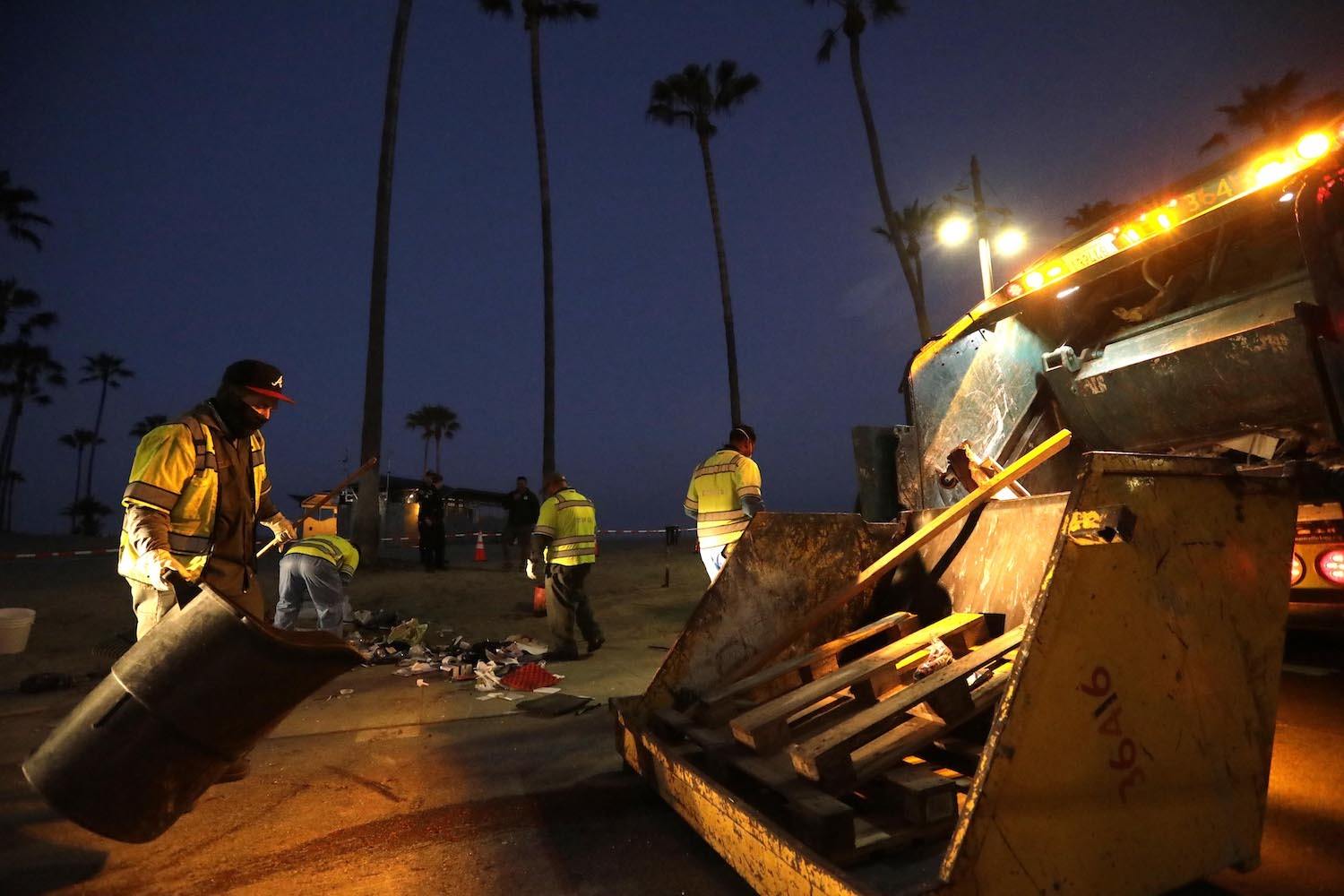
Sanitation workers began a boardwalk clean-up before dawn, but unlike that high-profile effort, inland clean-ups did not provide housing options or medical and mental health services.
The boardwalk clean-up made Linda worry that city workers were on their way up Rose Avenue to clear out her block. In anticipation, she opened a suitcase on the sidewalk and considered the contents of her tents, folded what she wanted to keep and placed those items in the case, and set aside the rejects in a wheeled cart.
Linda, who is in her 60s, has been in and out of apartments in various parts of Los Angeles, and unhoused for spells in between, since the 1980s. She had arrived across from the Rose, on Hampton, after a series of frightening episodes that she recounted one by one: Gang fights in one building that spilled into her apartment, a slumlord in another who let strangers move in and take over her place, her stuff stolen, her food poisoned. Recently she’d noticed a local security guard who had worked for the slumlord, she was sure, and thought it might mean trouble.
“I don’t know whether to stay or to go. It’s a sword they have hanging over our heads. It’s not good.”
“I thought it’d be better here,” she said. “Is it? No. There were rapes, gangbangers, guns in Santa Monica,” she said, where she had lived most recently, “and now they’re here in Venice. What are they doing following me?”
She thought she might go to Arizona, because it felt safer than Los Angeles, and because, she said, she had a small piece of property there. But first she had to get her belongings organized, and then she had to hope she could stay put until she got her second Pfizer vaccine, so that she would feel safe when she left the block. Linda had stopped taking what she called her “psych pills” because they dulled her senses. She felt safer without them. “The problem isn’t my mental illness,” she said, “which tells me to be very alert.”
For all the perceived threats of life on Hampton, her biggest concern was uncertainty. “I don’t know whether to stay or to go,” she said, staring down the block. “It’s a sword they have hanging over our heads. It’s not good.”
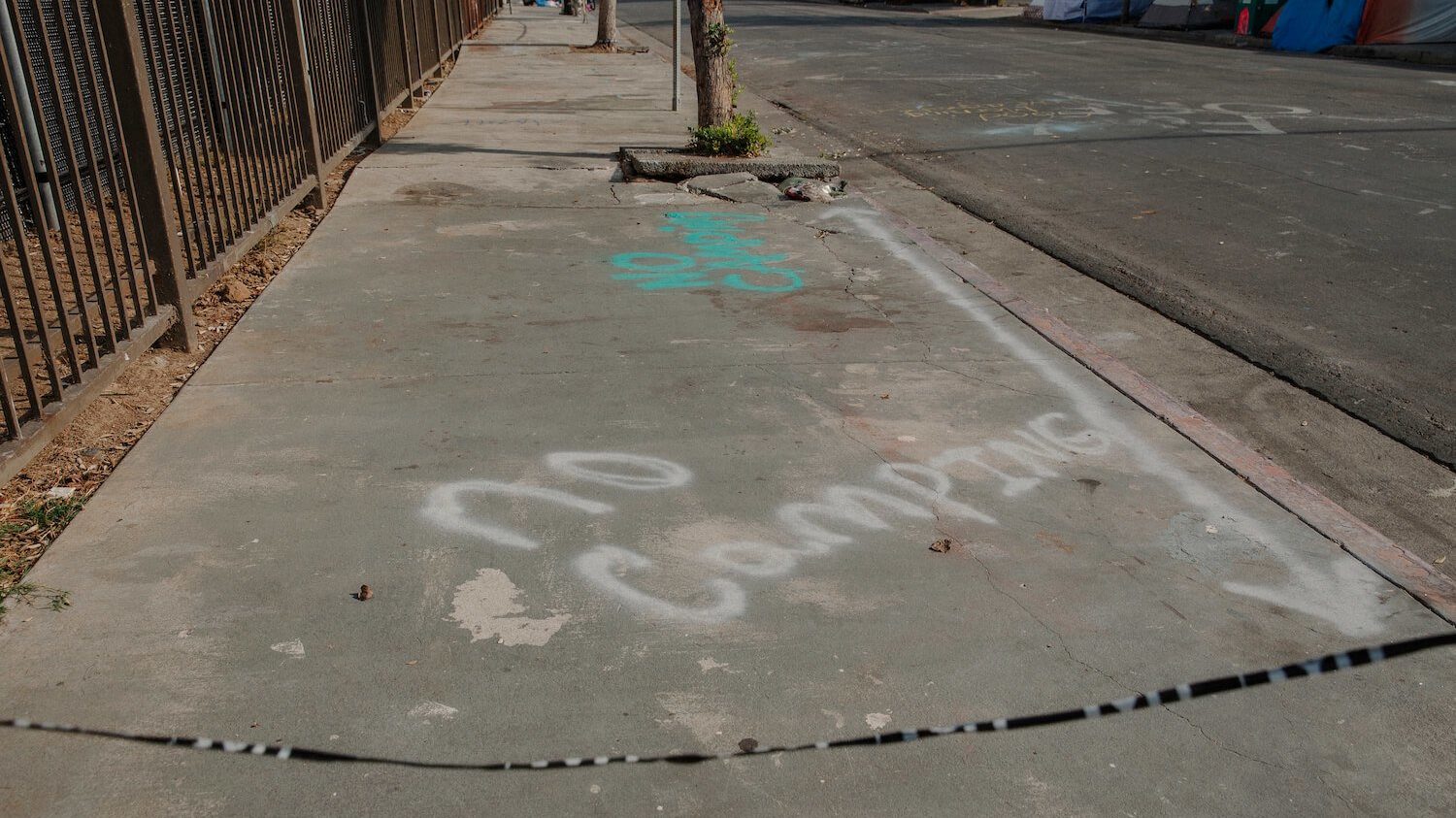
A move-on message on the sidewalk in front of the large storage facility on Third Avenue.
Samanta Helou Hernandez
Neroni wondered what the boardwalk clean-up meant, as well. He hoped it was the start of a resettlement campaign that would include Hampton Drive and Third Avenue—but he worried it was merely a move engineered by Bonin to show up the county sheriff, a one-shot effort on the most public stretch of tourist real estate.
He waited for some action, whether it was a clean-up or a meeting with the councilman, and kept up his incident log as the high-traffic summer ticked by. A naked woman dashed into the Rose and out a back exit. A clearly agitated man got in through the back patio entrance and took a table, as well, and Neroni had to get him back outside. He didn’t want to make trouble for the people living quietly in their tents on the street, but this was something else, a threat predictable only in its unpredictability.
The possibility of change started to take shape on July 28, when the L.A. City Council voted 13-2 to approve an amendment to municipal ordinance 41.18, an anti-camping rule that made it illegal to sit, sleep, or store belongings on specific kinds of public property like schools, libraries, and parks, or any place that “obstructs the public right of way.” But it wasn’t a binary move; it didn’t mean that living on Hampton Drive would be legal one day and illegal a day later. The city council had to vote on whether to enforce the ordinance at a proposed location, and then to post signs announcing intent, followed by a 14-day waiting period before taking action. A city report estimated that it could take up to four months to clear out an encampment, and that presupposed a city councilperson who supported the measure and identified areas in his district that should be part of the effort. Mike Bonin had voted against it.
—
Gjusta was a lightning rod for the debate over Venice’s future—a high-end bakery, deli, market, and restaurant that opened in 2014 a block south of the Rose on Sunset Avenue, at the opposite end of what was now the Third Avenue encampment. A Gjusta hamburger cost $19, and a club sandwich was $20, and that, along with a crowd that could afford not to think about price, caused a backlash among longtime residents who considered Gjusta to be an unwelcome interloper. They saw it as the kind of business that was beyond the reach of people who laid claim to Venice but had more and more trouble affording it. Gjusta might be in Venice, but it wasn’t of Venice—and its location, just steps from Google’s offices, seemed to confirm its interest in attracting wealthier new customers.
The Rose charged $20 for a “Double Smashburger” and $26 for a pizza, but it didn’t draw public ire the way Gjusta did. History was on its side—a local icon, named for its street, got a relative pass, especially with a newcomer nearby to siphon off negative attention.
“I don’t care to listen to myself talk about losing business. My only story is public safety because there is such an extreme problem.”
Gjusta owner Fran Camaj could see the length of the Third Avenue encampment from his second-floor office window, and he could tick off the ways in which it had changed over the past few years. He knew the location of what he called the “bike chop shop,” a double-wide structure where he bought back his wife’s stolen bicycle for $20. He saw people using and selling drugs, “twice as much as I’ve ever seen,” and watched fights break out and subside. Over the summer, he said, two men chased a woman to Gjusta’s doorstep because she’d been recording what Third Avenue looked like on her cell phone.
The neighborhood hadn’t been an obstacle before the pandemic, when weekend customers faced a formidable wait, but business was down, and some of the one-star reviews on Yelp complained about the challenge of navigating a safe path to Gjusta. Camaj, who has lived in Venice since the 1990s and has three children, insists, though, that business is not his primary concern. “I don’t care to listen to myself talk about losing business,” he said. “My only story is public safety because there is such an extreme problem.”
Unlike his restaurant neighbors, he had no expectation that the city would address homelessness in any meaningful way, because the city had failed to, so far. Camaj defined progress as improved co-existence, which seemed to him an attainable goal. As a first step, Los Angeles needed to replace super-structures with individual tents that are easier to keep clean and would re-open the sidewalks to pedestrians. Everyone would be better off.
“Venice could get stronger or fade away, and that would be quite a loss. People are welcome here, we look out for each other, that’s why there are so many people here. This gave me back my will to live.”
“If I was the city’s enforcement arm, in charge of what should humanely be done, then the super structures are just eliminated,” he said. “You’re allowed to have a sleeping bag and a small tent, and you’re not going to jail for being on the sidewalk. But you are absolutely not allowed a shelter that takes over a sidewalk multiple people are supposed to use. How can that be disguised as being humane?”
“My snap-of-the-finger thing would be to get uniform, city-of-Los-Angeles tents, provide a clean, brand new, waterproof structure,” he said. “There is no silver bullet, but as a step one.”
Short of that, Gjusta remained a sometimes challenging destination for people who had the resources to enjoy it—and a different kind of challenge to the people who couldn’t afford to, and who worried that its sibling restaurant, Gjelina, was one of the most popular spots on Abbott Kinney Boulevard. Gjusta might be an outlier, or it might be a harbinger of things to come on Rose Avenue. Not even Camaj could say, as long as things stayed the way they were.
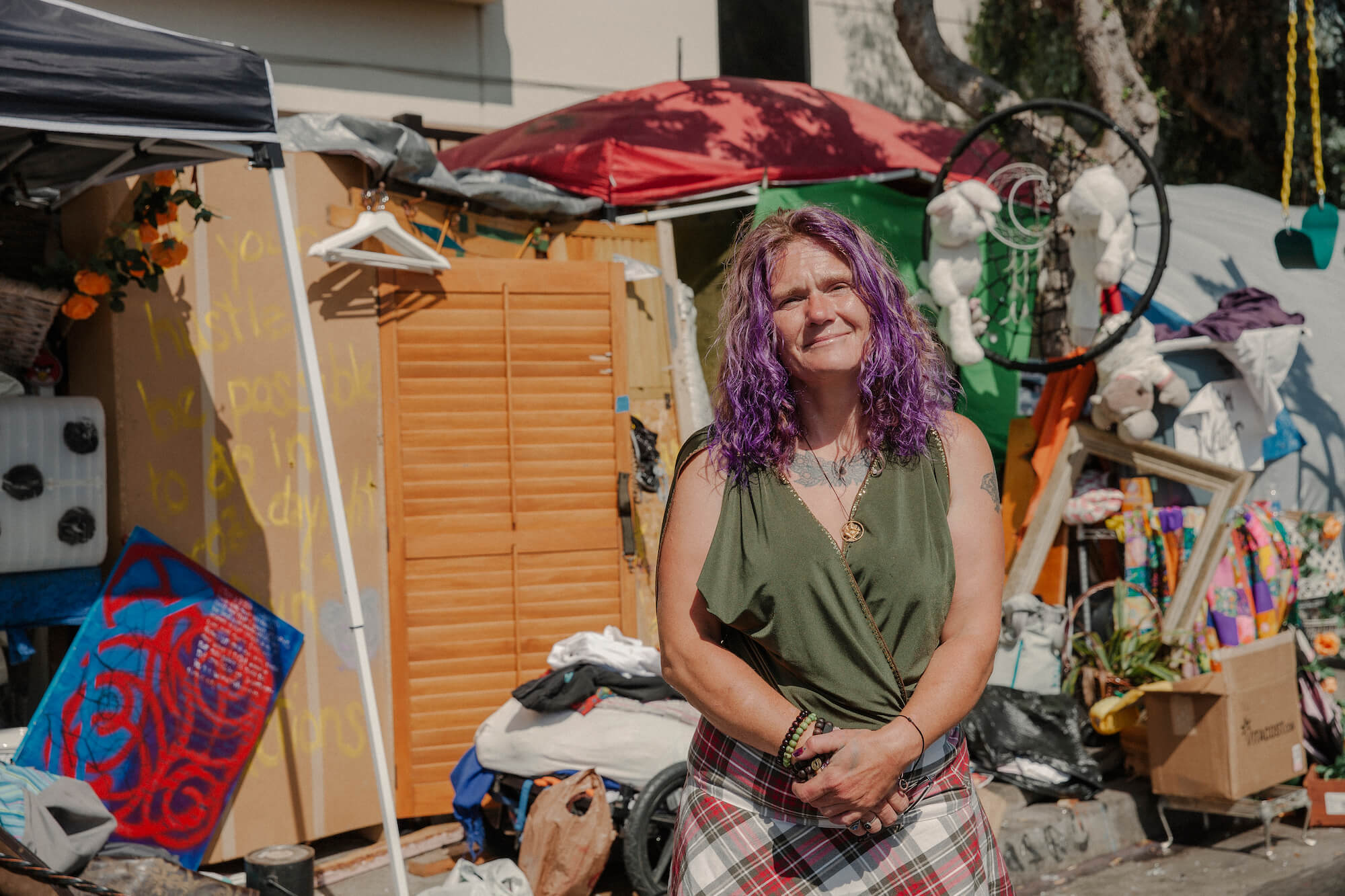
Georgeanne Ayers turned her Third Avenue shelter into a general store for her unhoused neighbors.
Samanta Helou Hernandez
Georgeanne Ayers lived in one of the rambling Third Avenue structures that Camaj wanted the city to outlaw, and had propped a large whiteboard in the middle of the street to announce her presence: “Know the facts. If you really knew the factors and all the factors of my situation (and many others) your opinion of us would shift and chances are you would see ‘Our Truths’ and Apologize. Take the chance and stop + speak to ME. Ask away.”
She had lived there for two years, she said, and as she got to know her neighbors she had embarked on a project to help them out. Ayers turned her home into a general store where people could look for what they needed, a sweatshirt or some socks or a toothbrush, and take it, or trade it, or give her a little money for it, whatever they could manage. She looked for inventory in trash receptacles—in the uppermost layers, the stuff that hadn’t been sitting there for too long—and was always grateful to locals who bagged up usable items and set them on the sidewalk next to the trash, knowing that someone might want the contents. She accepted donations from her neighbors on the street as well, from people who thought someone else might need a particular item more than themselves.
“The space is mine, but I can’t seem to get it done. Everyone needs something, and they’ll stop me from getting it done.”
Ayers had become too successful; her inventory spilled out toward the curb and past the temporary side walls of her space, blurring the line between her store and the part of the structure she lived and slept in and making it hard for her to organize two distinct areas. “The space is mine,” she said, “but I can’t seem to get it done. Everyone needs something, and they’ll stop me from getting it done.”
Those everyones were as close to family as Ayers got, and she started to cry as soon as I asked where she came from. Pennsylvania and a family of “misfits,” she said, four children, one of them dead before he could get off probation and join her in California, and relatives who would not let her talk to her two youngest children, though she intended “to take that on, but not now. I have to wait until I have some resources.”
Resources required stability, which had eluded her so far. She’d traveled for a while before she found Venice, and now all she wanted was to stay put. “I like what I see,” she said. “Venice could get stronger or fade away,” she said, “and that would be quite a loss. People are welcome here, we look out for each other, that’s why there are so many people here. This gave me back my will to live.”
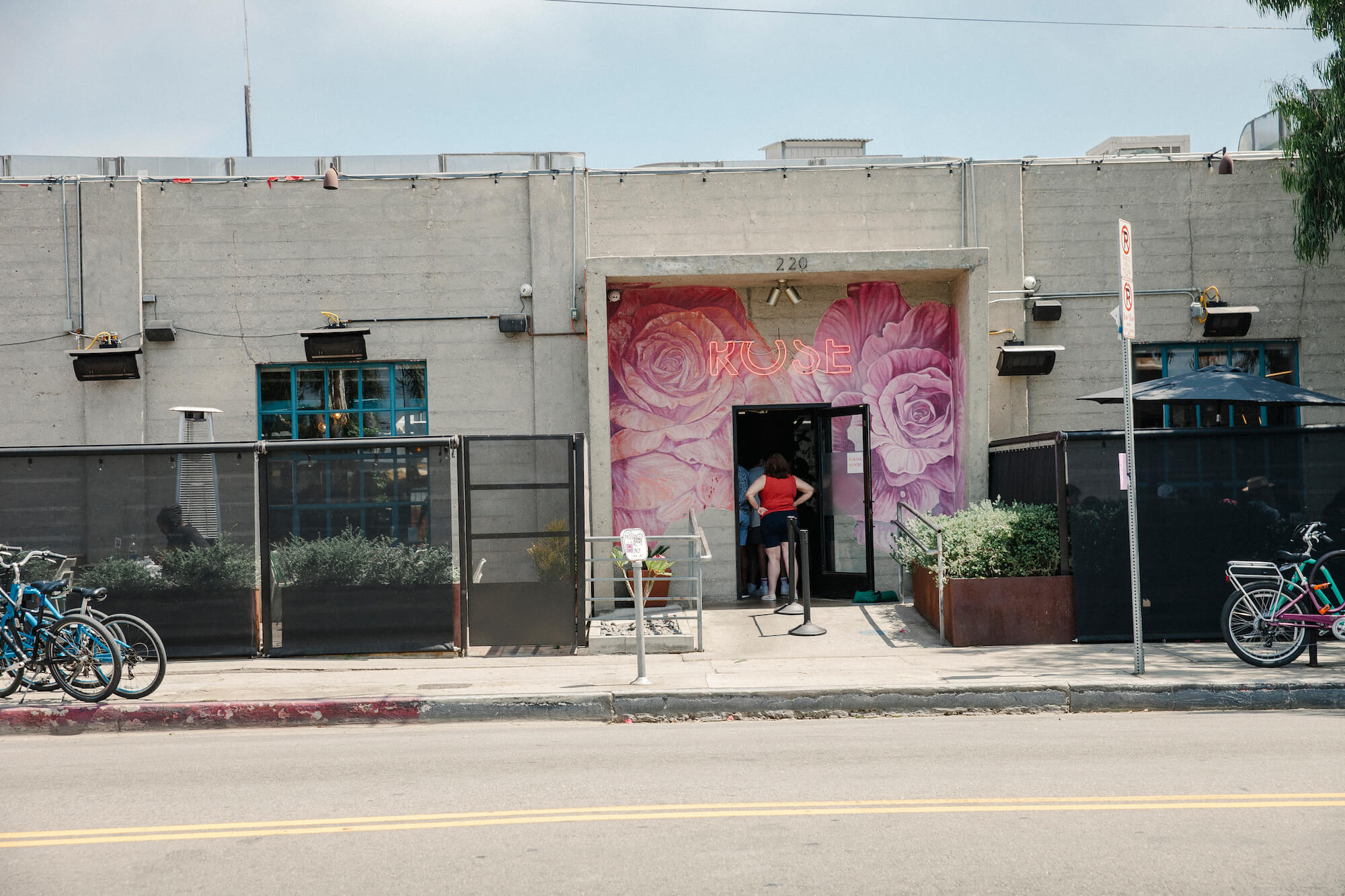
The Rose Venice, two blocks from the Pacific Ocean, has been a neighborhood institution since 1979. Its current owners took over in 2015.
Samanta Helou Hernandez
Almost three months after Neroni’s first email, on August 5, Councilman Mike Bonin arrived at the Rose accompanied by four uniformed LAPD officers and one of his staff members. Neroni’s contingent included his wife, Jennifer, and representatives of his business partner’s management company and the family that owned the Rose.
They sat on the restaurant’s back patio as Neroni pressed for answers, and afterward, the chef and his wife tried to make sense of what had just happened. When he complained about his unanswered 911 calls, one of the officers assured him that response time was six minutes, and when Neroni disagreed—“That’s not true in our case”—the officer explained that to get an immediate response he needed to say he was calling about a violent incident in progress.
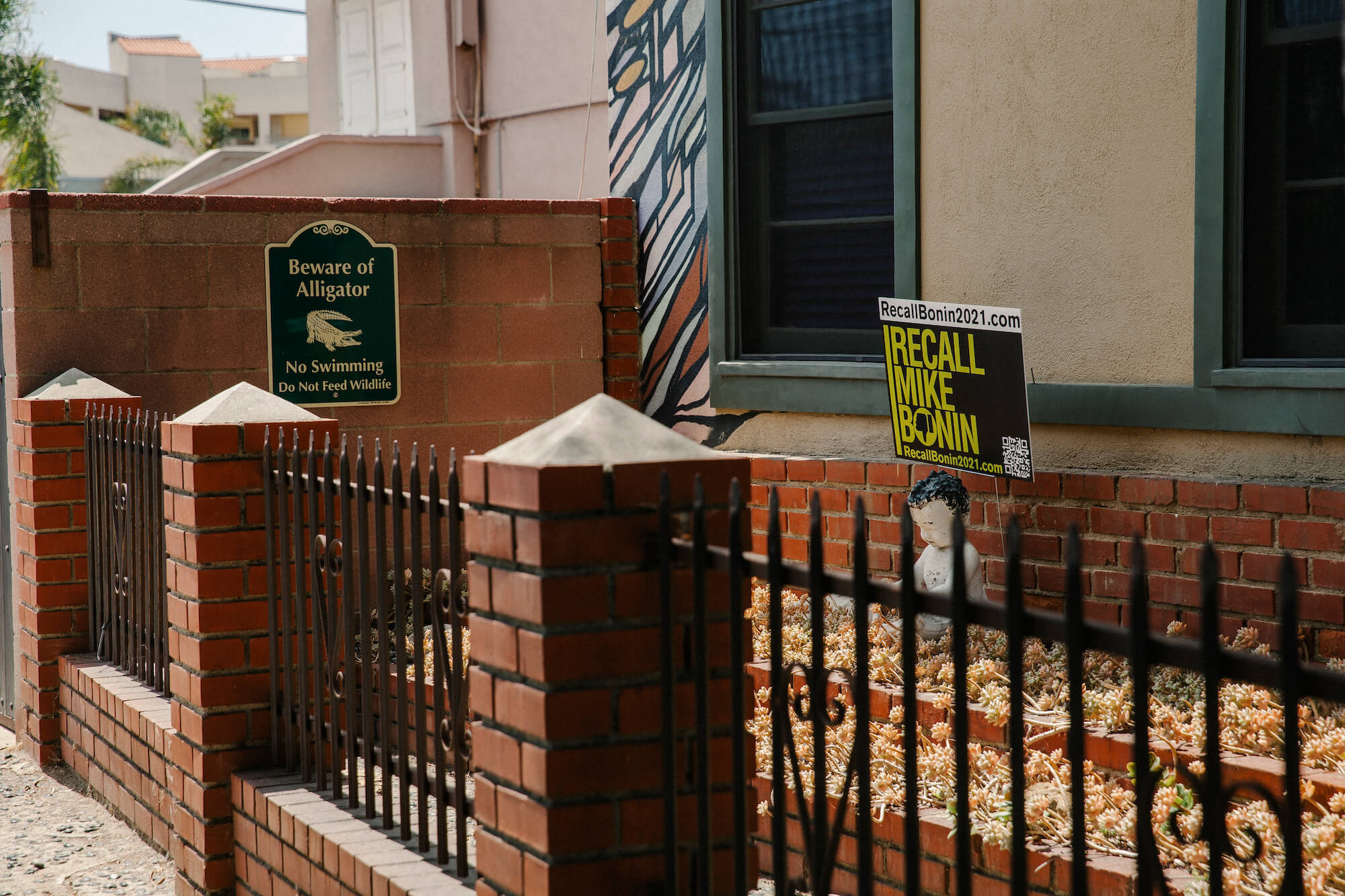
Frustrated locals watched other city council districts clear out encampments, and hope that a recall election next May will replace Mike Bonin with someone who has a new plan for addressing homelessness.
Samanta Helou Hernandez
The rest confused him, so Jennifer consulted her notes. “He did say he’s committed to doing more enforcement around here, but enforcement of what?” There had been no mention of the anti-camping amendment, which was scheduled to go into effect on September 3 but required Bonin to nominate the area for clean-up. There might be more thorough street cleanings that would require people to abandon bigger structures for more portable ones, but that was just a return to the way things had been before the pandemic.
Neroni appealed to his wife: Did she think their complaints had registered?
“I don’t know,” said Jennifer. “He certainly made it look like he was listening. But I don’t know.”
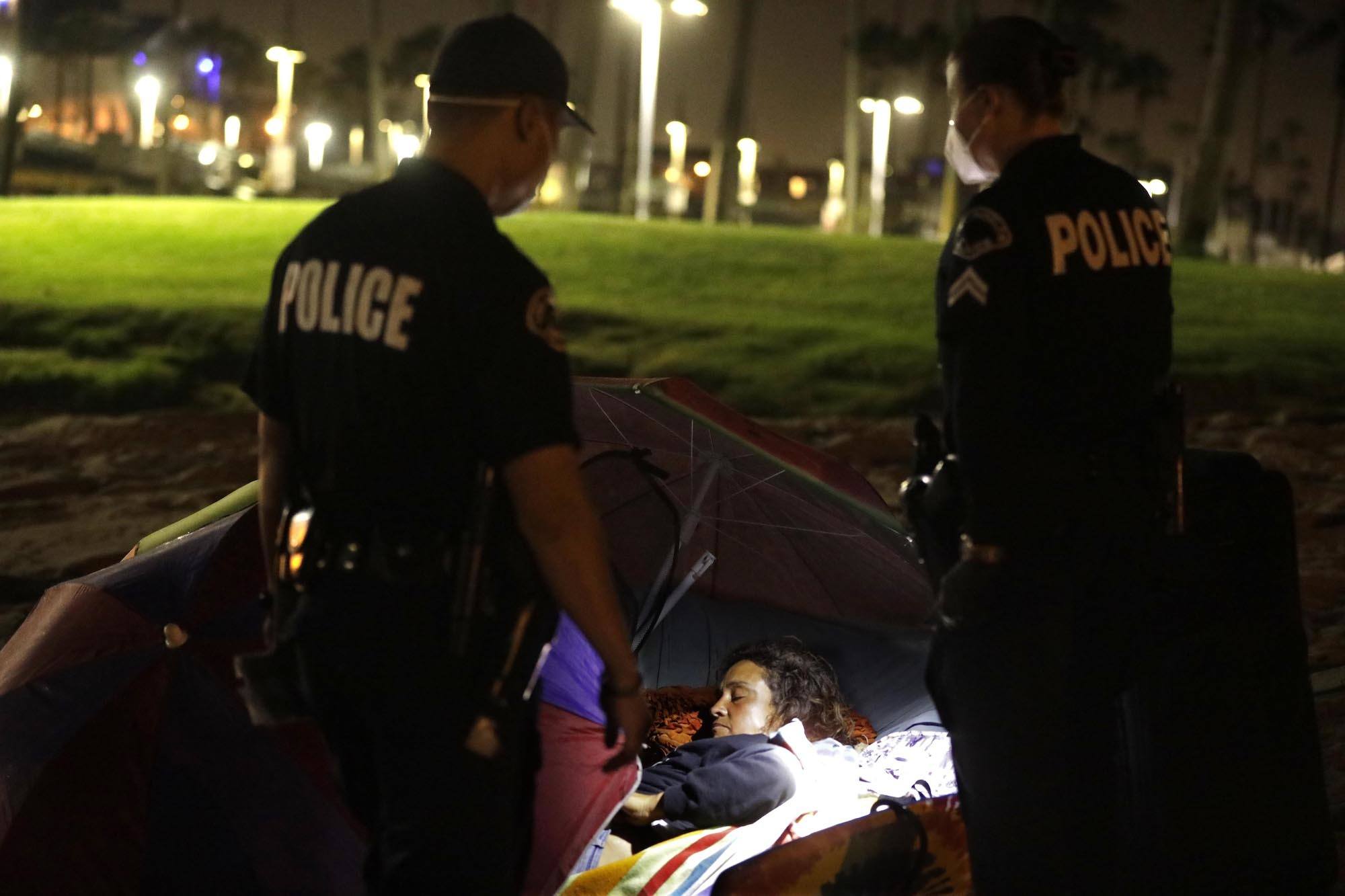
Advocates complain that the LAPD is too hands-on, while some residents and businesspeople complain they are too hands-off. Officers say their behavior is defined by new pandemic-era rules.
If a 911 caller says that a violent crime is in progress, officers know to “drop everything [they’re] doing and respond straight to that call,” said Captain Steve Embrich, commanding officer of LAPD’s Pacific Area, which includes Rose Avenue. But if a Rose Venice manager said that a guy is standing on the corner acting out, it was a non-priority call, unlikely to get a response. That was the crucial distinction Embrich and his officers had tried to convey to Neroni.
“It happens all the time,” said Sergeant Brian Cook, who also attended the meeting at the Rose and is responsible for eight senior lead officers on the west side of Los Angeles. “Communicating the facts of what is actually occurring, and the immediacy, sometimes does not happen.”
The LAPD draws criticism from both sides of the Rose Avenue conversation: advocates who fear another incident like the Echo Park clean-up across town, where an estimated 100 officers participated in a contentious, surprise dismantling of a large encampment, and residents and businesspeople who want officers to be more aggressive. But LAPD’s mandate, according to officers responsible for neighborhood enforcement, is defined by three operational lists: What they used to do and can’t, right now; what they never did, despite what people think their job is; and what they wish they could do.
“Homelessness is just a symptom of the actual problem, which is mental illness or narcotics abuse. You have to deal with that problem, and not just one of its symptoms, because otherwise you’re just moving the problem indoors and out of sight.’”
What they can’t do is enforce ordinances that have been suspended during the pandemic. It used to be illegal to keep a tent in place between 6 in the morning and 9 at night, and to park any vehicle anywhere for more than 72 hours, or on weekly street-cleaning days. Now it isn’t, which has led to super-structures, people living in lone parked cars, and rows of campers that don’t move.
What they’ve never done? Intervened in any but the most serious incidents involving mental health issues, because they have no mandate to do so. The city has no dedicated mental health budget, and the county is stretched thin, but the county and nonprofit service providers are supposed to handle all but the most extreme incidents. The LAPD steps in only if a situation meets one of three criteria. “There is always outreach encouraged before any type of enforcement effort,” said Embrich. “We only get involved once somebody is in crisis and they are a threat to themselves, or to others, or they’re gravely disabled, in which case we would do a 5150 mental health hold.”
That’s not what local residents want to hear. “People will call and say, ‘You’re not doing anything with this person,’” said Cook, “but sometimes they don’t meet the criteria for us to detain them. It’s not illegal to be mentally ill.”
“When it’s all over, we just see people pop up in other places.”
What the officers wish they could do is enforce drug laws in a way that motivates drug users to seek treatment. Proposition 47, passed in 2014, reduced drug possession from a felony to a misdemeanor and retroactively cut sentences to align with the new guidelines. It was designed to keep people out of jail for minor possession charges, but the officers are focused on unintended consequences: Lighter penalties, combined with cheaper and more powerful drugs, and super-structures big enough to protect sellers and buyers from discovery by the police, have led to an explosion of drug use that has redefined the neighborhood.
“There’s always the threat of violence,” said senior lead officer Acosta. “If anybody has any kind of means, or ways of having another place to go—families that lost a job, in other parts of the city I know of families that are living out of an RV, with kids—they’re not going to be in the Venice area,” said Acosta, “if they have the choice to go somewhere else that is not so active.”
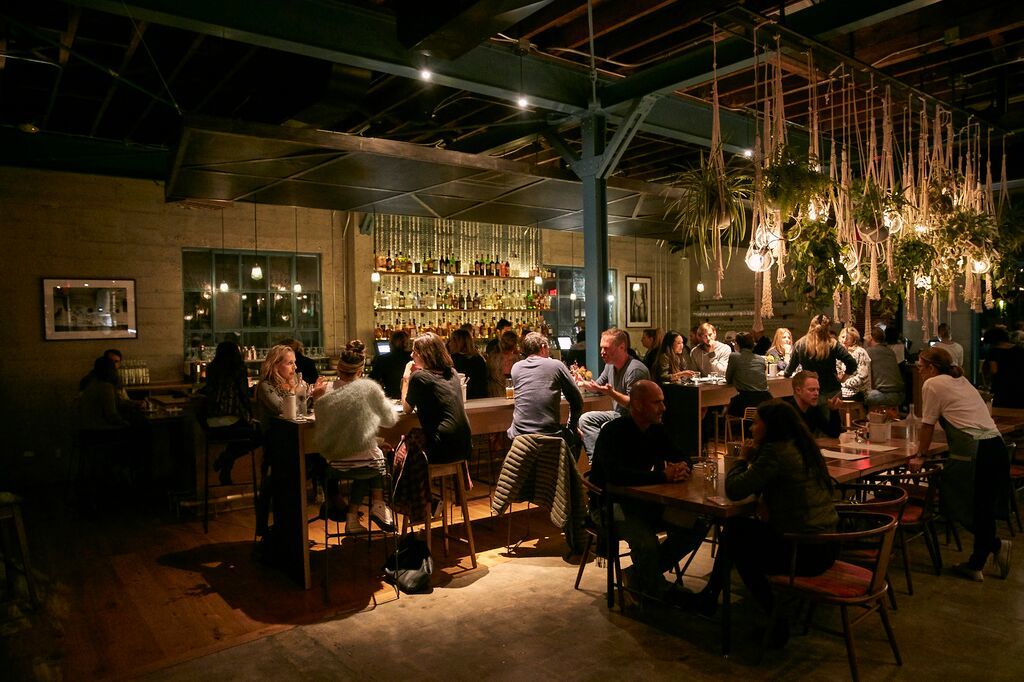
As diners venture out again, the Rose and other restaurants hope the street can regain its balance.
Pascal Shirley
Halfway through my conversation with the three officers, Embrich broke in to make sure his priority was clear. Drugs are “the second biggest factor after mental health issues as far as persons we get into violent confrontations with,” he said. It would “perhaps be looked at as one of the key changes that led to the expansion of homelessness and addiction.”
Karen Lauterbach, at the Venice Family Clinic, saw the same problem from a completely different angle. “Criminalizing it doesn’t help anyone, doesn’t make them say, ‘Oh, right, you’re right, I won’t live on the street anymore,’” she said. “And that criminal record will impact their ability to get a job—if you have two applicants, one with a criminal record and one without, who do you go with?”
But Embrich is adamant. “Homelessness is just a symptom of the actual problem,” he said, “which is mental illness or narcotics abuse. You have to deal with that problem, and not just one of its symptoms, because otherwise you’re just moving the problem indoors and out of sight.’”
The challenge of helping the city’s over 41,000 unhoused people had spiraled out of reach of the various groups who continued to argue about the best approach.
In the meantime, the best he could offer Rose Avenue restaurateurs was a list of practical steps to reduce the likelihood of a confrontation. They could lock their bathroom doors and post a sign saying that bathrooms were solely for customers’ use, and block exits if they couldn’t control who came in and out. If they posted no-trespassing signs, an officer might be able to detain someone, assuming the call got answered in time. And restaurant people could work together on a more coordinated effort—if the street meant that much to them, they ought to communicate about how best to preserve its character.
The LAPD was available to share such advice, if asked, but relied on local business owners to initiate the conversation or ask for a meeting. Owners who weren’t aware of the option, like the restaurateurs on Rose, expected the police to take the first step, and felt neglected when they didn’t.
Door locks and signs were hardly a perfect solution, but Embrich had come to understand that there wasn’t one, that the challenge of helping the city’s over 41,000 unhoused people had spiraled out of reach of the various groups who continued to argue about the best approach. It wasn’t really a solution at all, just a series of protective measures, but at least it was a start.
—
Sanitation workers and LAPD officers arrived on Hampton Drive on the morning of August 19, and by 11 a.m., the sanitation team had cleared out the southern half of the block, its residents told to get what they could carry off the sidewalk; the rest would be thrown away. This was not an extension of the boardwalk clean-up. There were no St. Joseph volunteers with the promise of already-arranged temporary housing, no transportation to that housing, no conversations about available services for people who were not yet ready to move. Venice Family Clinic wasn’t there to connect with people who might relocate and be hard to find for their weekly injections or other medical care. It was, effectively, a restoration of existing city services, nothing more. The difference, this time, was that the encampments had changed and grown over almost 18 months of suspended city activity. It was one thing to pack up a tent, quite another to pack up a structure and its contents.
The clinic’s Lauterbach was exasperated by the lack of coordination with support services, which fairly guaranteed that nothing would change except for people’s locations. “When it’s all over,” she said, “we just see people pop up in other places.”
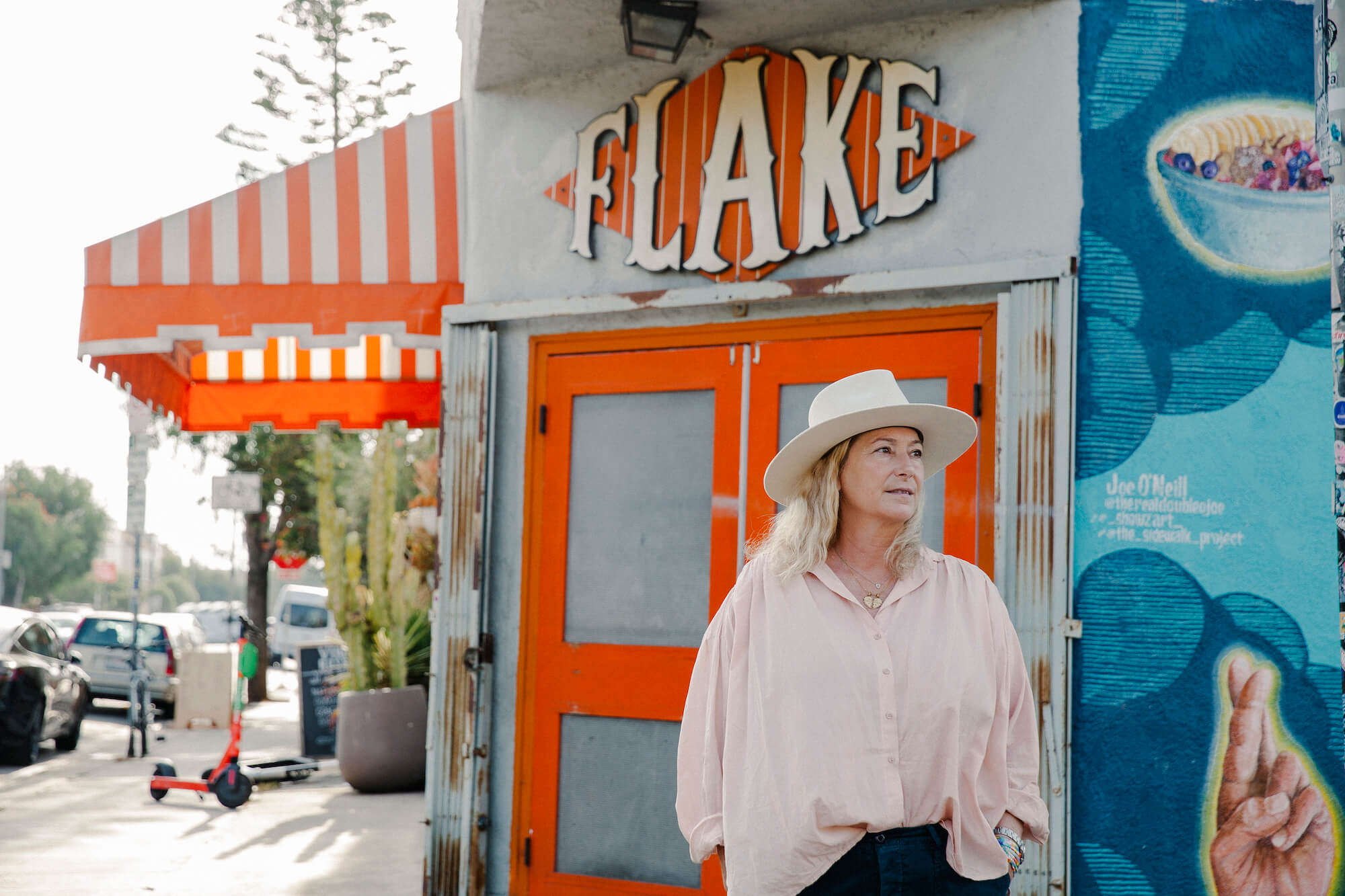
Paige Clay, owner of Flake, said that Rose Avenue’s culture faces threats from opposite directions—a more unpredictable homeless population that made the street feel unsafe, and a post-tech, moneyed population that isn’t interested in Venice’s boho pedigree.
Samanta Helou Hernandez
If the unhoused community in Venice reflected the cumulative effects of the economy and the pandemic, so too did the restaurants that lined the street. Three of them sat in a row a block down from the clinic, equidistant from the encampments and the row of campers at the eastern end of the strip, each one a distinct point on the street’s timeline.
Paige Clay, who opened her breakfast-and-lunch place, Flake, in 2008, is the kind of owner who passed on the chance to build parklet outdoor seating—she didn’t want to deprive her neighbors of parking spaces they desperately needed at night. She’s eliminated indoor seating and relies primarily on take-out, with just a handful of spindly tables and a bench alongside the building, but Flake is still, she said, “an anchor spot for the community.” A knot of people gather around the order window early on weekend mornings.
It’s a low-key operation, from the sun-faded awning to the hand-painted mural proclaiming Flake the “House of the Cro-Jo,” a breakfast sandwich built on a croissant. This isn’t cuisine, it’s what Clay called “cheap and cheerful” food, designed not to awe but to make her customers happy, including many neighborhood restaurant workers who can afford her menu but not the ones where they work. She uses American cheese on the burritos and sells sandwiches with names like The Fatty, the Happy Hippie Wrap, and Bubba’s Basic. During the peak summer season, she works the line assembling salads and sandwiches while her cooks make the hot dishes.
“After Google and Snap came in, things really, really changed. The clientele skews younger, with much more disposable income. And just not as invested in the community. It’s not the same.”
Lately Clay felt a “menacing” squeeze from both ends of the economic spectrum. When she opened Flake there had been fewer people without a permanent place to live, and less of a divide between those who had resources and those who didn’t. “It was different for homeless people when we started,” said Clay. “They lived in their vehicles, for the most part, and they were part of the larger community,” including a man who worked for her as a dishwasher. She fed people all the time, simply because she had food and they didn’t.
If she fed them now, it was often part of a barter negotiation to get them to move on. “If you’re dealing with someone who’s mentally competent it’s easy,” she said. “It’s, ‘Hey, if I give you a sandwich will you take yourself down the street?’ But today there was a guy sitting on my bench, just hollering. There are more people on the street who are mentally ill, or have a dual diagnosis, that and drug or alcohol addiction, and it scares people.”
She’s had people overdose in her bathroom, and confessed to occasional “empathy fatigue,” which she believes is widespread among restaurant people who feel ignored by city officials, and manifests itself in practical questions about enforcement gaps.
“I do believe there are laws on the books that if we just enforced them, we might not be in this mess,” she said, unaware of the enforcement moratorium. “There’s no sleeping on the beach, so why aren’t we enforcing that? There is no overnight parking. Or if I park on street-cleaning day and don’t move in time, I get a ticket, which I have to pay because I don’t want my car impounded. If I park a food truck somewhere it’s not supposed to be, they’ll tow it away. So why do campers just sit there?”
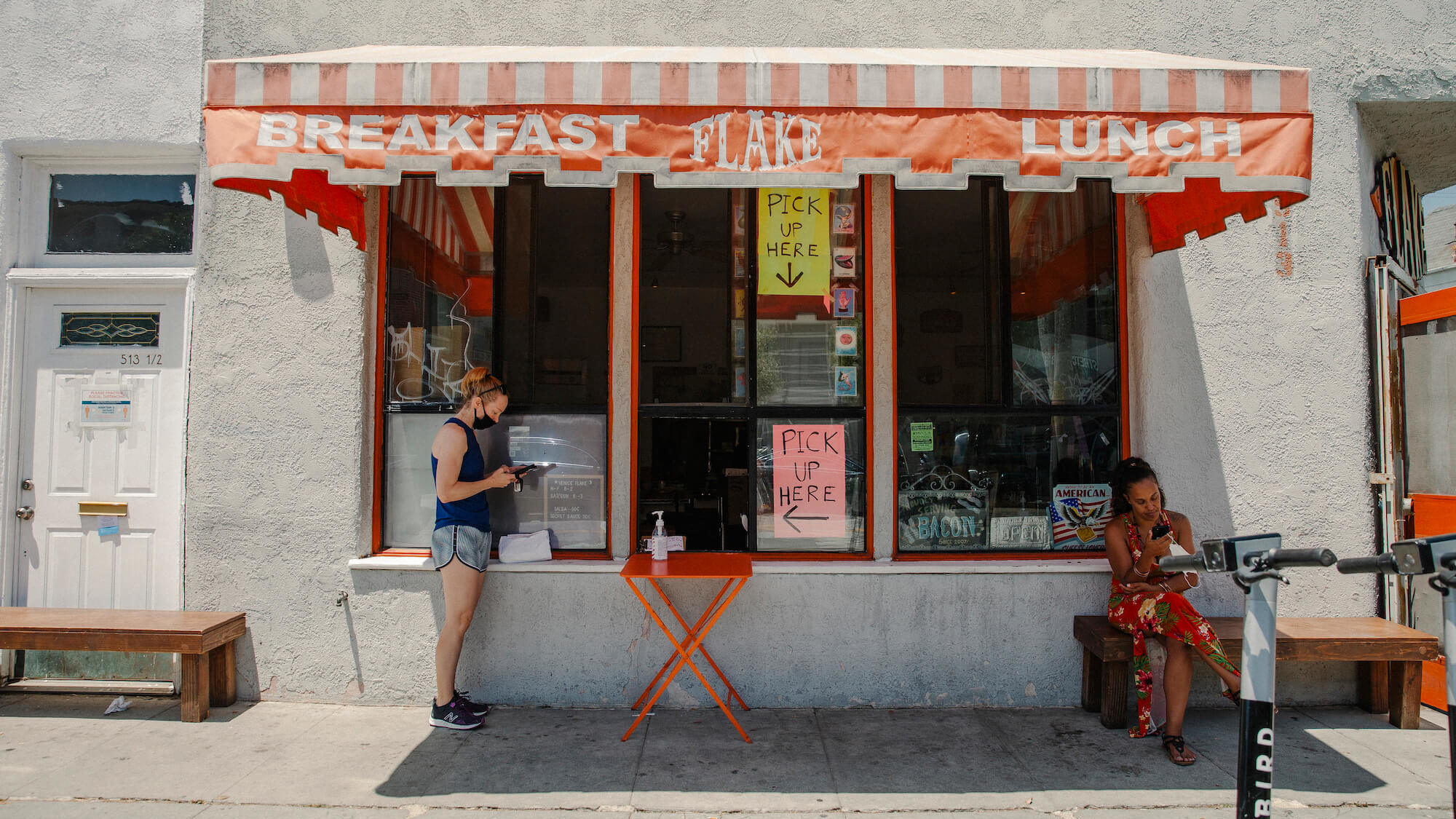
Flake offers some of the cheapest food on the street, and its customers include restaurant employees who can’t afford the menu where they work.
Samanta Helou Hernandez
She was equally frustrated by the influx of big spenders who made weekend nights on Rose “absolutely insane,” from what she’d seen, and grateful that her day ended at two in the afternoon. Flake used to attract “artists and young families,” she said, but many of those original customers had been priced out of the area.
“If I have to come down here in the evening it’s shocking to me,” she said. “After Google and Snap came in, things really, really changed. The clientele skews younger, with much more disposable income. And just not as invested in the community. It’s not the same.”
Joshua Woollen, a 22-year Venice resident who lives just down the street from Flake and is a regular customer, was drawn to the neighborhood at first, he said, because of its “edgy style—as vast as L.A. is, Venice is walkable, bikeable, all-encompassing, and once you’re here you find the community gathering places.” Now he is warier than he used to be.
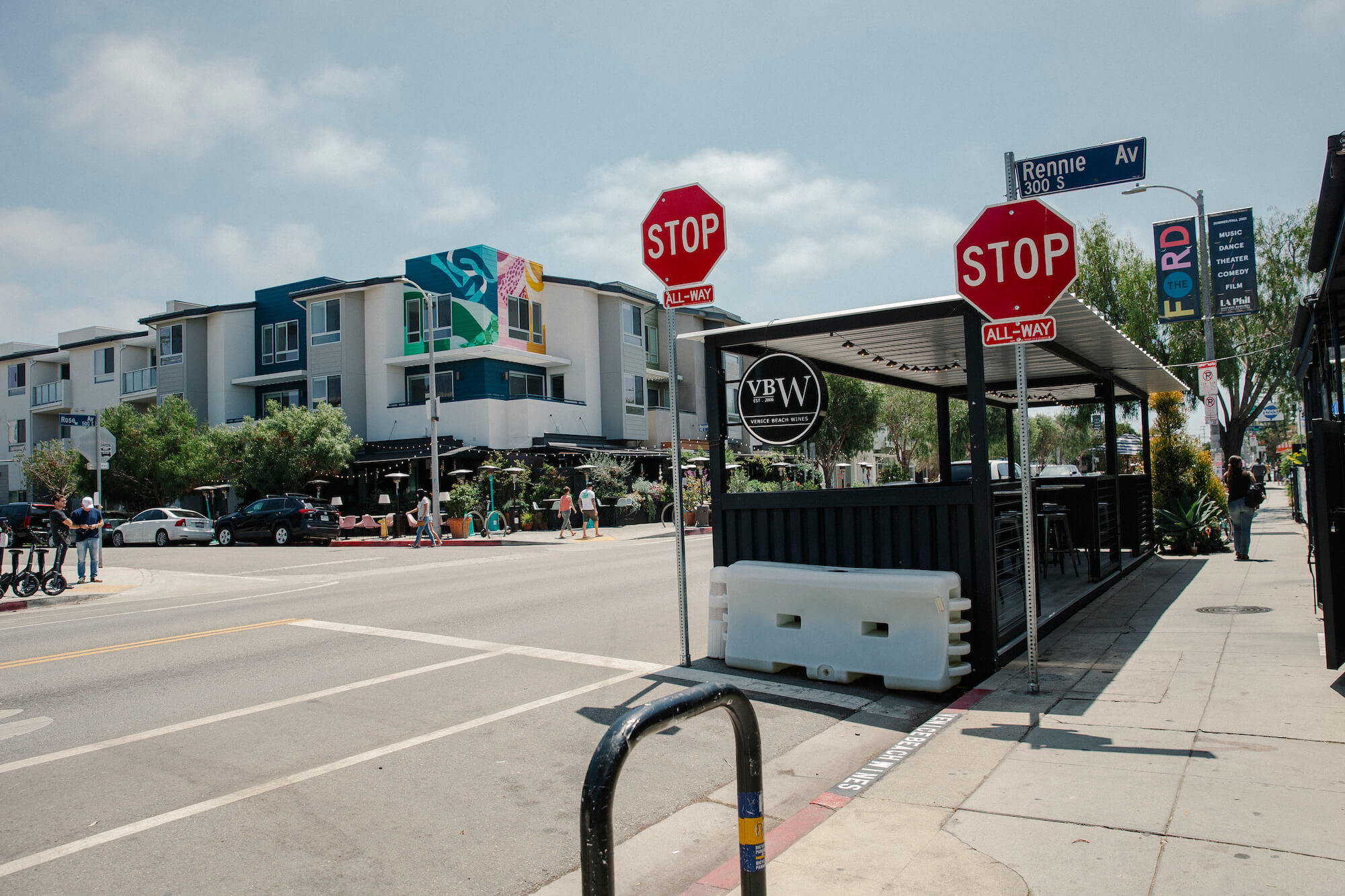
The owners of Venice Beach Wines were social workers before they turned to restaurants, and it’s their informed opinion that current interventions aren’t going to yield long-term solutions.
Samanta Helou Hernandez
“I might be heading to a restaurant for dinner,” he said, “but I might choose not to walk down Third Avenue, or even cross to the other side of Rose, because someone’s acting out. And I’m extra-cautious with my kids, who are 11 and 14. I keep them close.”
“Outside my door there’s lots of non-positive engagement, violent incidents that people don’t know how to deal with,” he said. “There’s always been a population on the streets, but this is the worst I’ve seen since the late 1990s.”
—
Oscar Hermosillo and Norma Alvarado own Venice Beach Wines (VBW), a half-block up from Flake, which opened as a wine store in 2006 and was converted to a restaurant in 2010. Before that they spent 16 years as social workers, so they look for the overarching solution, not the street-level strategy, but Hermosillo doesn’t see much to give him hope. Existing interventions are doomed to failure, he believes—and viable alternatives don’t exist, and are unlikely to any time soon.
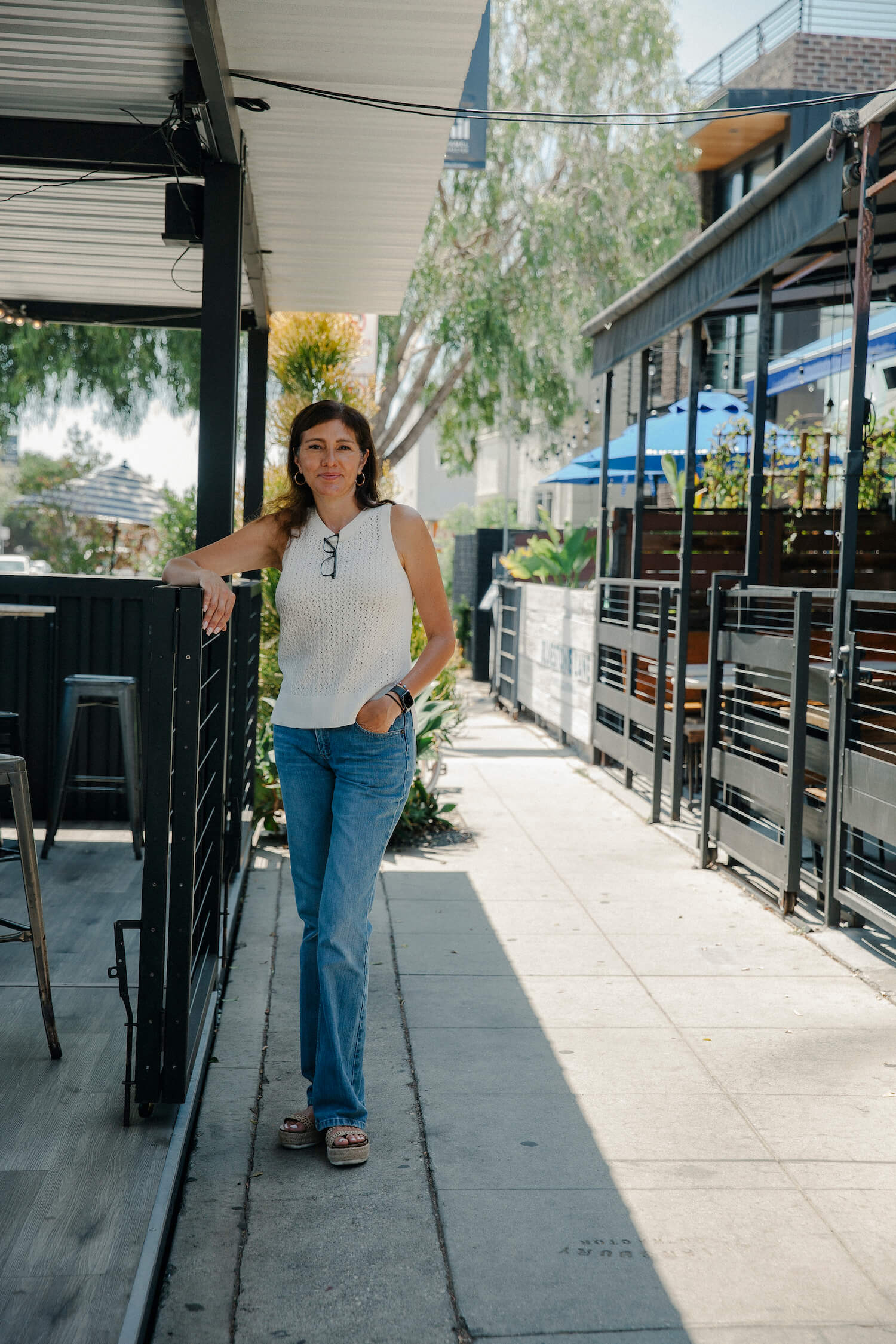
Norma Alvarado, co-owner of Venice Beach Wines, is proud that the street’s kept big franchises out and avoided becoming the next trendy Abbott Kinney Boulevard, at least so far.
Samanta Helou Hernandez
The neighborhood had become “a ticking time bomb,” he wrote in an email, because of people “peddling strong, more aggressive drugs to the needy.” He dismissed street clean-ups as “a Band-Aid” that scattered people throughout the neighborhood rather than finding housing for them, “admirable in its intent but short-sighted.” A more lasting solution would require two things in short supply—a broader, coordinated effort among groups too often antagonistic toward each other, and more money. Creative thinking would help, as well: Hermosillo liked the idea of taxing companies that use public infrastructure, like Amazon and Google. He’d like to see a tax on every mile an Amazon truck drives in 90291, the Venice zip code.
Failing that kind of change, the couple was left to address problems as they arose. When they got a call from another business owner who’d seen people sleeping in VBW’s parklet, they installed a locked gate.
—
Rose Avenue means everything to Tony Gutierrez, the operations manager at Chulita, a three-year-old Mexican restaurant a few doors up from Venice Beach Wines. He’d landed there after 10 years of working at various L.A. restaurants, but Chulita was the work-home he’d been looking for, and he was determined to protect it—and his neighbors as well. If LAPD wasn’t going to show up when there was a problem, he would figure it out himself.
“They’re allowing us to become the authority,” he said, so he did. If he sensed a problem with someone, he tried talking first, “because sometimes that’s all they need, the homeless, is a word. They spend a lot of time alone. I talk to them the way I want to be talked to.” If that didn’t work, he signaled the guys who worked there to step forward, for a show of strength. As a last resort, he had a baseball bat stashed in the host stand, “not to swing, ever,” he said. “It’s to scare people off.” He broke up one fight between two men who seemed high just by yelling at them to “bring them out of their state of mind.”
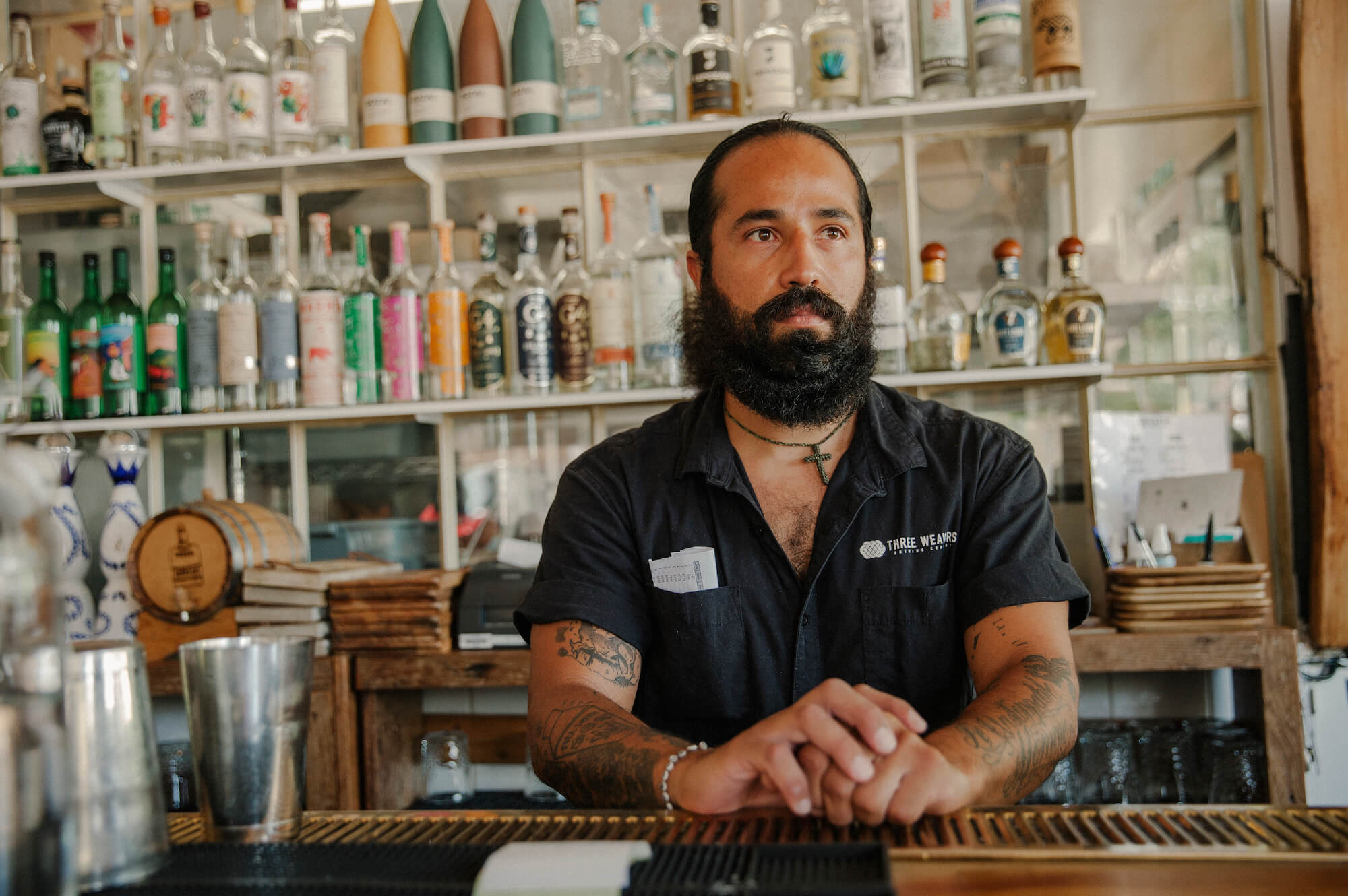
Tony Gutierrez, the operations manager at Chulita, has only worked on Rose Avenue for three years, but sees himself as a guardian of the community he’s come to value.
Samanta Helou Hernandez
“I felt good about it,” he said. “I did my part.”
Chulita’s corner location gave him a good view of nearby restaurants, and as the summer wore on he became the block’s self-appointed guardian—not quite the collaborative effort LAPD recommended, but better than nothing. One night a man punched him in the chest and then took off down the block, so Gutierrez sprinted to Venice Beach Wines to warn Norma Alvarado, in case it was the next stop on the man’s itinerary. “This guy looks normal, but he’s off his rocker,” he told her.
—
Mr. William Earle Jones sees himself in a role similar to Gutierrez’, “a monitor,” he said, who bicycles down the street to keep an eye on younger Rose Avenue residents, offering advice on how to stay out of trouble. His motor home sits alongside the Whole Foods parking lot at Rose and Lincoln: He bought it at that location a year ago, and it doesn’t run, so that is where he lives.
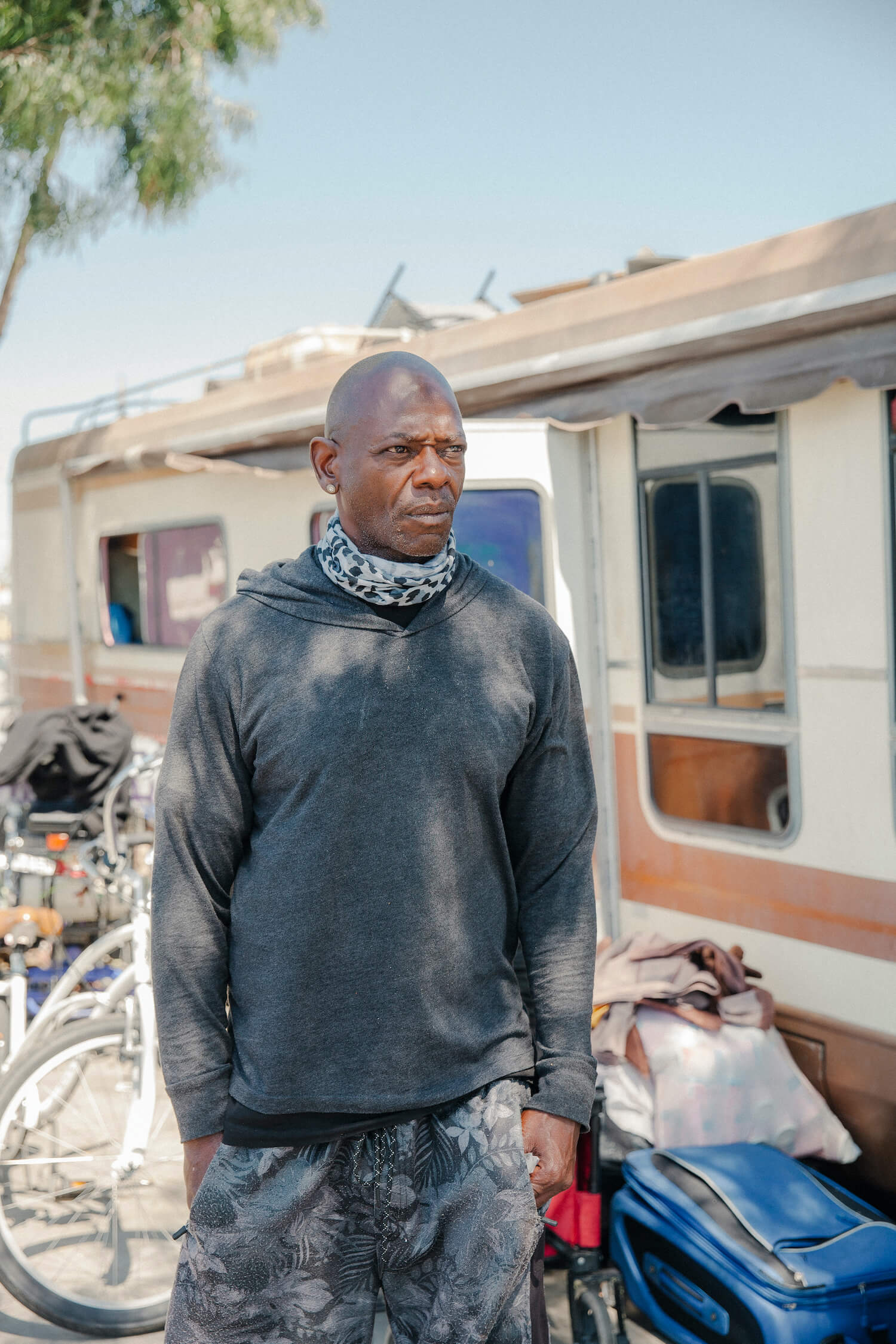
Mr. William Earle Jones, a neighborhood monitor like Gutierrez, whose primary concern is fentanyl use among younger unhoused neighbors.
Samanta Helou Hernandez
Before the pandemic, he was a courtesy clerk at a Westside market, working the parking lot, helping customers and workers, but he lost that job during the shutdown. Now he sat outside among possessions that included a chair, a bicycle, and other items lined up along the sidewalk. He has a mailing address on Hampton, and said that he was owed a good deal of money that hadn’t yet arrived, including unemployment checks, an income tax refund, and more. Mr. Jones last had a home address in 2014, and since then he’d seen a run of bad luck he summed up as his “predicament,” including a shelter he had to move out of, a fiancée he broke up with, and his current inability to find a job.
But his time on Rose has given him a new mission: to warn people about fentanyl, which is, as far as he is concerned, the primary obstacle to getting off the street and into housing and a job. “My job is to keep fentanyl out of this community,” he said. “I’m with the cops on that. It’s not party drugs out here, it’s fentanyl, and they’re putting it in everything.”
—
On September 9, LAPD parked SUVs sideways across Rose Avenue, blocking the entrance to Third Avenue, and ran yellow caution tape to cordon off sanitation workers as they embarked on another round of street-cleaning, this one more challenging because the encampment was much larger than the one on Hampton Drive. And possibly more contentious: LAPD officers stood close to the workers and garbage trucks to provide support as residents found out they had to relocate.
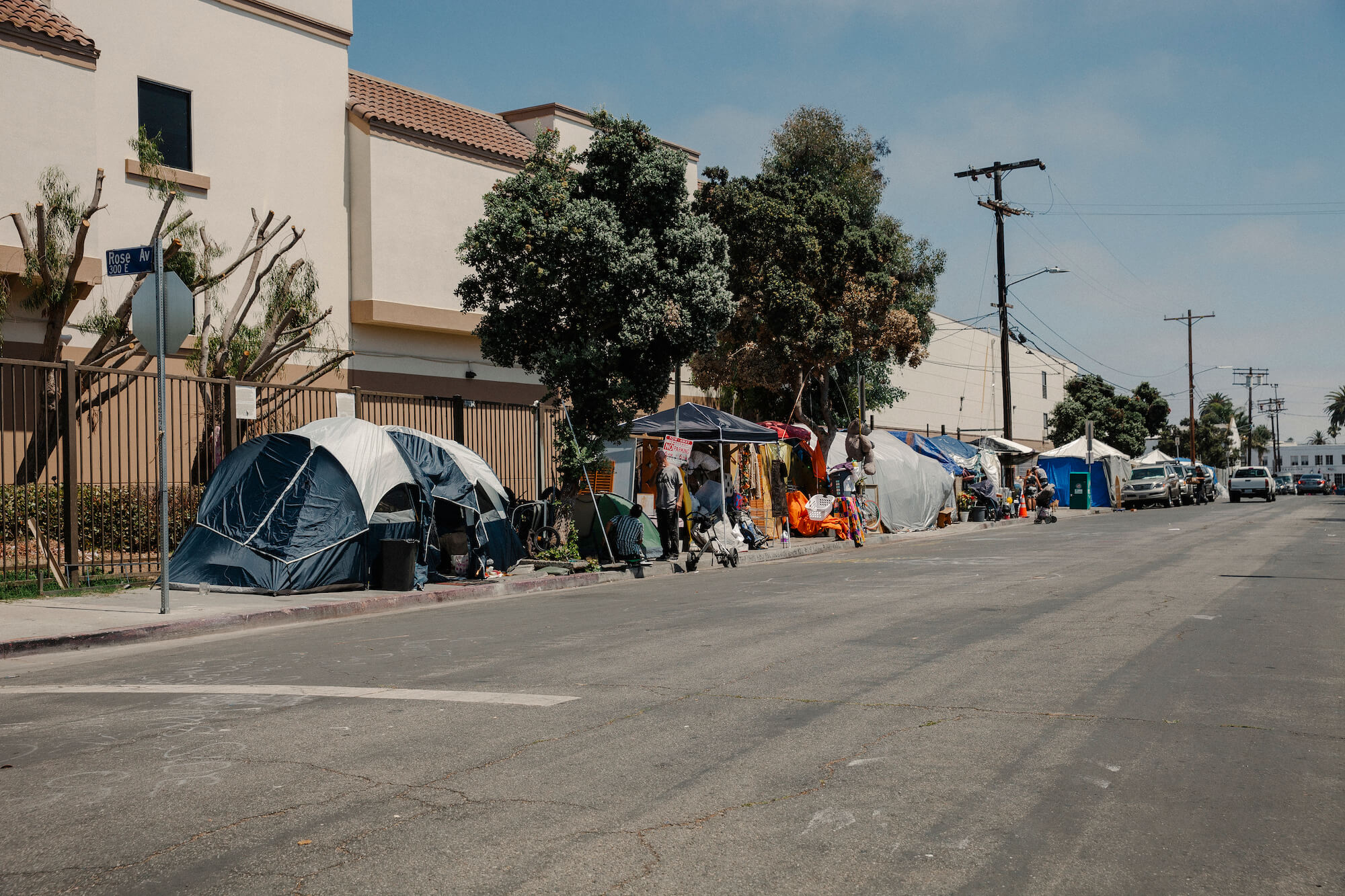
The Third Avenue encampment ran a block from Rose Avenue to Sunset Avenue, where Gjusta owner Fran Camaj worried about public health and safety and wished that the city would issue uniform one-person tents as a first step.
Samanta Helou Hernandez
The amendment to municipal ordinance 41.18 may have gone into effect officially over Labor Day weekend, starting the clock on a potential no-camping enforcement, but in the meantime the city was back to cleaning Hampton Drive and Third Avenue.
By mid-morning one couple had hauled a pile of their belongings, including a mattress, to the other side of Rose Avenue, where they watched the proceedings, half their possessions on the sidewalk, half spilling into the street. Other people dragged what they could around the corner, onto Rose Avenue. Some grabbed essential items—posted signs advised them on how to protect or store documents and valuables—and watched as what they left behind was hoisted into garbage trucks.
“My job is to keep fentanyl out of this community. I’m with the cops on that. It’s not party drugs out here, it’s fentanyl, and they’re putting it in everything.”
No one had alerted the Venice Family Clinic or St. Joseph, and as the day wore on a quartet of clinic employees wandered the space, looking a bit shell-shocked and talking quietly among themselves, trying to figure out if there was some way to be of use. An advocate for unhoused people ducked under the caution tape and started to take photos of the signs and the workers, until a local woman loudly confronted her. The woman’s mother had been knocked down by an unhoused person, she said, so how could the advocate defend their right to be here? The advocate suggested, as loudly, that one person’s mom was not the center of the problem, and they were off, voices raised, insults hurled, until a man driving by on a motorcycle pulled over to join the fray. He had a daughter with mental health problems who was on the street, he said, waving his helmet menacingly, for emphasis. That was the priority. The two women didn’t know what they were talking about.
A young man who had dragged his tent onto Rose stepped over and began to tell the motorcyclist about his own mental health issues, in a low, calming voice, and just like that, the group split up, each headed in their own direction, possessed of the same absolute positions they’d held when they first raised their voices.
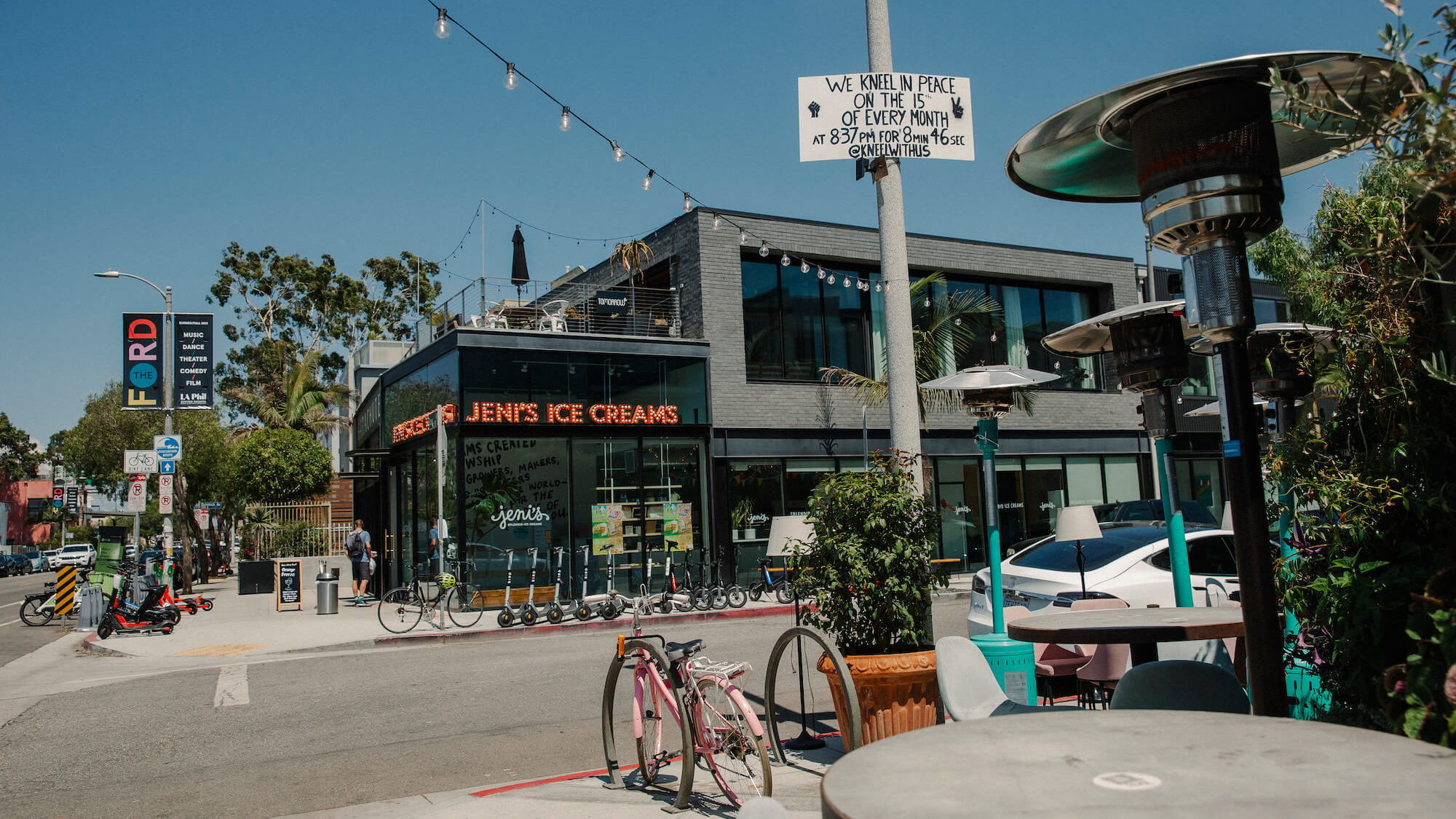
There are a few small chains on Rose Avenue, but independent restaurants and businesses dominate the almost mile-long business district.
Samanta Helou Hernandez
Rose Avenue represents a sliver of the nation’s unhoused population—over 580,000 people in need of permanent housing, 39 percent of them Black, 23 percent of them Latino, 20 percent of them children, all facing a reduced life expectancy because of the time they have spent on the street. Cities across the country face impossible life-or-death choices: In Washington, D.C., city officials asked the mayor to postpone a plan to clear out two encampments from December until March, when hypothermia would be less of a threat to people who either refused offers of housing or were not on the list to receive such offers.
In that context, what happens on Rose might seem small, but it is part of a repeating pattern in urban centers across the country, hardly the only place where the pandemic has redrawn a neighborhood. Up and down the West Coast, urban business districts that aren’t yet at full capacity are home to a growing number of people who lack permanent shelter and gravitate toward areas where they are more likely to be left alone. Portland, Oregon, chef Vitaly Paley closed restaurants in three downtown hotels and blamed the combination of a dormant downtown and an increase in the number of unhoused residents nearby. And in Denver, the locally-based Teriyaki Madness chain closed its only corporate-owned outpost and cited the same combination of empty offices and unhoused people living in the area.
Up and down the West Coast, urban business districts that aren’t yet at full capacity are home to a growing number of people who lack permanent shelter and gravitate toward areas where they are more likely to be left alone.
Seattle and San Francisco face a situation more similar to the one in Venice, as an increasing number of unhoused people move into business districts that rely on both local residents and tourists—the downtown area around Seattle’s famous Pike Place Market and Pioneer Square, and San Francisco’s Tenderloin and Market Street neighborhoods. But the sheer size of Venice’s population dwarfs what’s going on in Seattle, and the city’s director of economic development chose to promote that fact, telling a local public radio outlet that the city was “damn lucky” the problem wasn’t any worse, and suggesting a shift in focus toward that positive message. San Francisco, whose unhoused population has been an intractable problem for four decades, settled a 2020 lawsuit with Tenderloin residents and merchants who accused the city of using their neighborhood as a “containment zone,” and promised to make “all reasonable efforts” to relocate people to temporary housing or safe overnight spaces. A group of Market Street residents and businesses filed a similar suit a month later.
In its recent report, “Outside the Law: The Legal War Against Unhoused People,” the American Civil Liberties Union in California suggested a dramatic redefinition of the issue, calling for legislation to make the homeless population a protected class, safe from discrimination based on their housing status. Such legislation would shield the unhoused from arrest, disruptive clean-ups, and any actions based on where and how they live, and would require cities to “[i]nvest in subsidized, permanent affordable housing, social housing and services.”
California’s track record on that front is less than promising: The New York Times columnist Jay Caspian Kang, who endorsed the ACLU report, wrote that the state had “effectively squandered $2.7 billion in bond resources” that should’ve been spent on affordable housing. Los Angeles, for its part, had appealed an April 2021 court order to place $1 billion in escrow, immediately, to supply housing to the entire population of the city’s Skid Row within 180 days—and in September, a federal appeals court struck down a portion of the April decision that calls its entire future into question.
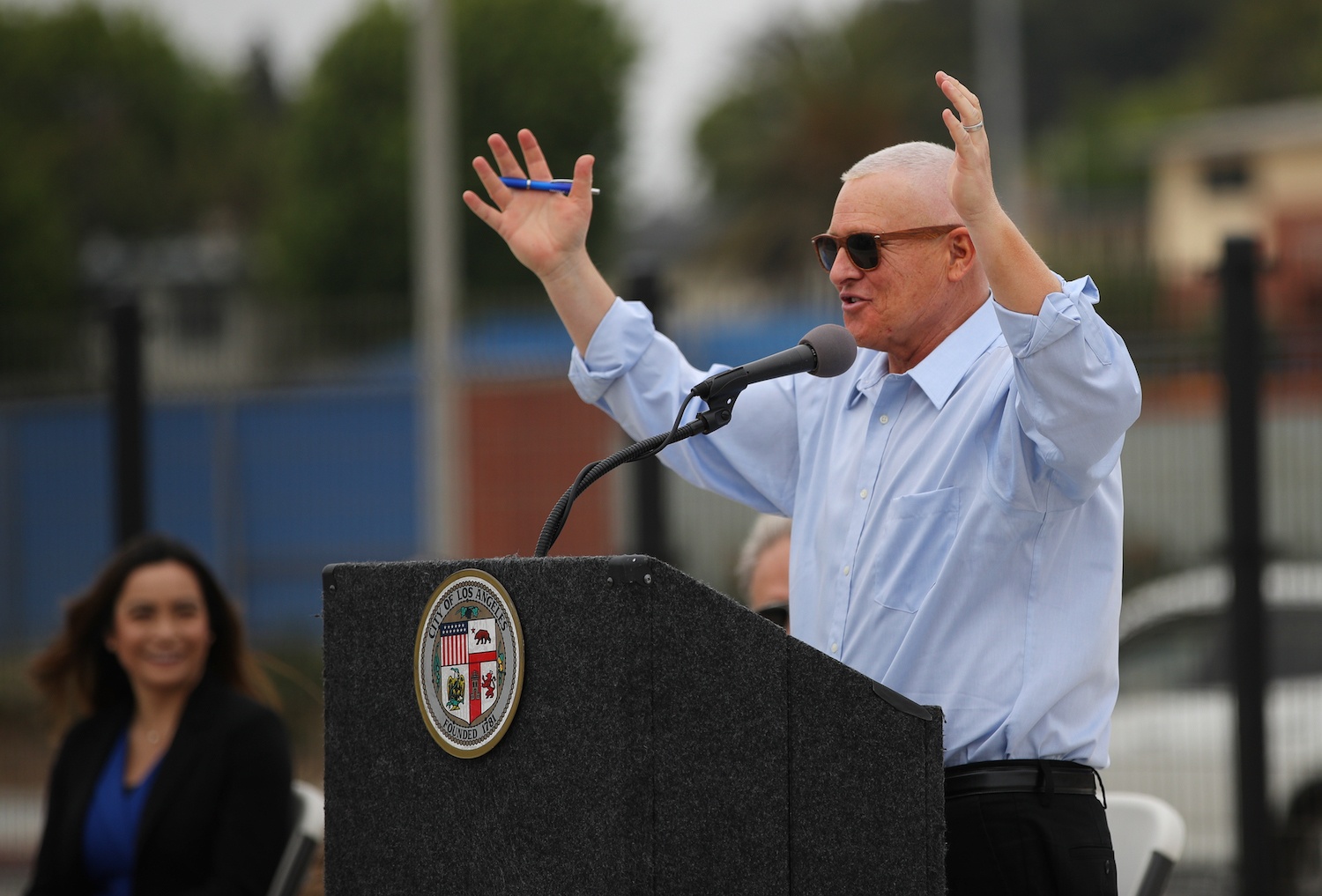
City Councilman Mike Bonin, a vocal advocate for the unhoused, faces a recall effort because Venice residents and businesspeople feel he’s done too little to remedy the situation.
Councilman Mike Bonin stands 180 degrees from LAPD officers who said that drug use and untreated mental health issues lead to homelessness. From his vantage point, too few permanent beds is the central problem, and finding more of them the only path to a solution. “If I’m living on the street and I get sober,” said Bonin, who is 26 years sober after struggling with alcohol and methamphetamine addiction, “I’m still homeless. Getting people inside doesn’t magically make them sober, but it’s a lot easier to do indoors.”
The city needs more permanent beds even if people have to spend time in temporary housing before they make the transition. And it needs more drug and mental health recovery services to help them do it successfully, all of which take time and money. If he had enough resources—and if he survives the recall next spring and wins the general election—Bonin is confident he could meet his goal for Rose Avenue by the end of his final term: “I’d hope people won’t be living in tents or RVs on Rose. I wouldn’t say I’m rosy and optimistic, but I’m focused and determined about it. It can happen.”
“It’s key. When somebody says yes to housing, you have to have someplace for them.”
“Getting people inside doesn’t magically make them sober, but it’s a lot easier to do indoors.”
He admits that his vision of the future depends on optimal conditions, while real life is anything but. Venice can greatly increase its housing supply only if increased funding continues, if more city council members support the 10-year housing vouchers the federal government has made available to end the cycle of temporary housing followed by a return to the street, and if there are sufficient wraparound services to provide mental health and addiction care. If someone solves the “chronic” problem of high real estate prices on the west side, which make it harder to purchase or lease potential housing. If someone can figure out inflated per-unit costs and reduce them.
The city “doesn’t have all the resources in its menu” to make the plan work, he said, conceding that his approach might require a controversial change in the criteria for involuntary commitment of the mentally ill. It pains him to say so, but Bonin thinks there needs to be a broader definition of what it means to be a danger to oneself, to allow for interventions with people who can’t function on their own.
“People can try to legislate homelessness away, but it doesn’t work. You can say, ‘You can’t be homeless,’ but that doesn’t make you housed.”
But as far as he’s concerned, housing is the only viable option of the three currently under contentious debate. “There’s the status quo, where everyone loses,” he said. “and criminalization perpetuates the cycle, disconnects people from services and housing, and pushes the problem to another block or neighborhood.”
Bonin’s critics are anything but patient, which frustrates him. “Not everybody in Venice has been here for 15 to 20 years,” said Bonin, who has lived in the area since 1991, “and they say, ‘Who’s this guy who says we need to have homeless housing here?’ But it’s been a 20-year conversation. At some point the umpire has to call the play.”
“People can try to legislate homelessness away, but it doesn’t work,” he said. “You can say, ‘You can’t be homeless,’ but that doesn’t make you housed.”
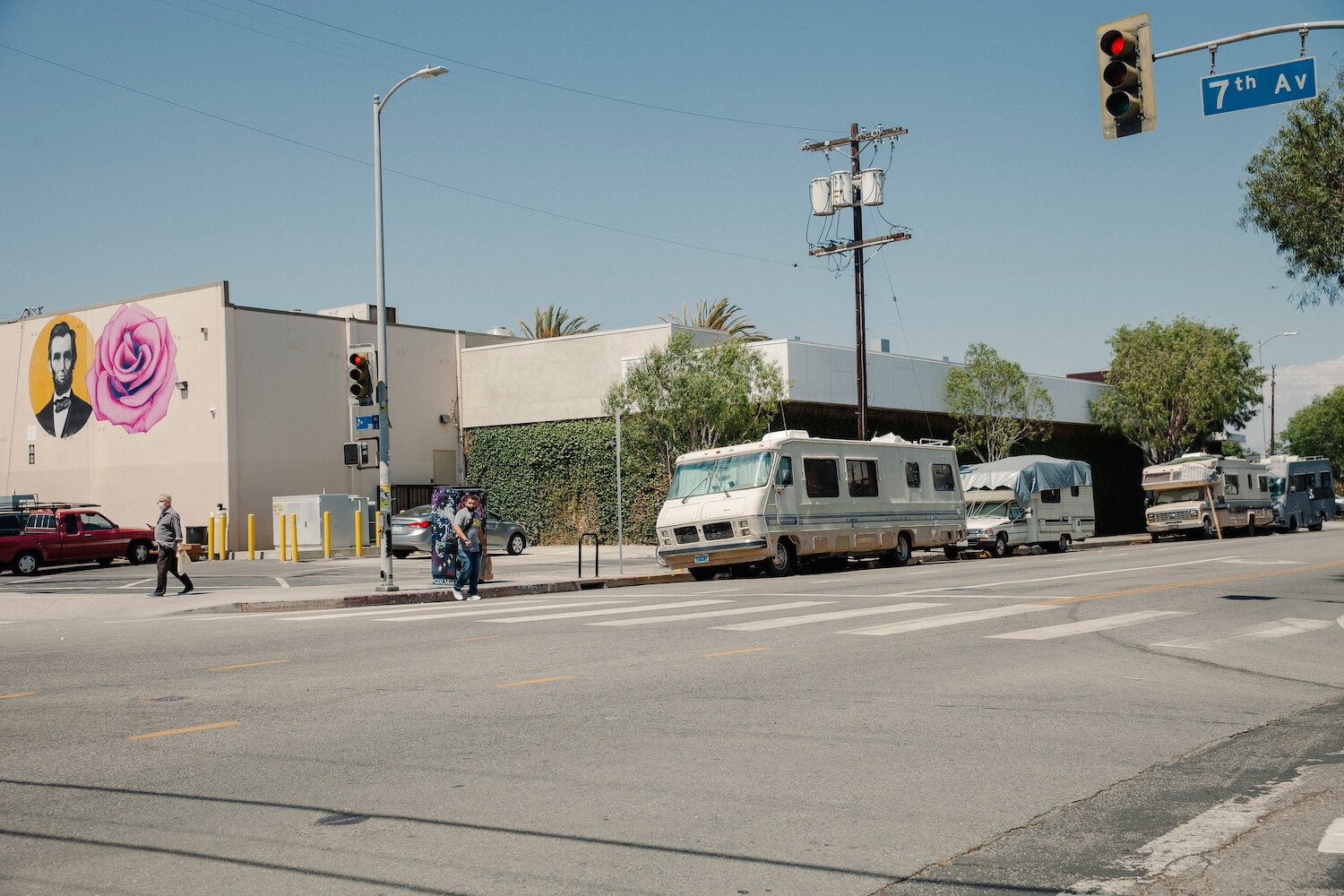
Campers and motor homes going nowhere, parked permanently outside the Whole Foods at the eastern end of the Rose Avenue business district.
Samanta Helou Hernandez
Whatever becomes of Rose Avenue, it won’t be the street it should be. That is George Francisco’s harsh appraisal, and he offered to walk down Rose Avenue with me to explain how it was supposed to look, a rare opportunity for him to describe his vision without being shouted down.
His vision for Rose Avenue is “European,” he said, in the tradition of its namesake and other European cities known for walking streets that mix storefronts at ground level and residential space upstairs. There would be public parking at Lincoln Boulevard, so that people from anywhere, tourists or residents of other L.A. neighborhoods, could find easy parking—a serious enticement in a city where circling for blocks searching for a space is often the reason people decide to stay home.
“Rose Avenue is what many people want. We want to go where the locals go, go to the indies, they want to be first on the scene and find something new and different.”
That way, the city could eliminate the parking requirements that currently hobble Rose Avenue businesses. And liquor licenses would be easier to get, not to turn the street into one long pub crawl but to make it easier to sell drinks, which is where restaurants make most of their profits. More mixed-use permits would enable the owners of residential buildings to lease their ground-floor space to a small business, while owners of single-story businesses could add housing upstairs and increase the area’s strapped inventory.
Even the block-long storage facility at Third and Rose had potential, though an earlier effort to transform it had failed: There was plenty of space between the building and the Rose-facing sidewalk, just the place for small covered businesses, from food pop-ups to artists’ galleries.
The street would be independent, not corporate, full of smaller businesses like the ones already trying to get by on Rose. There were no encampments on Francisco’s imaginary street, but that’s what got him back to angry. The city and the nonprofits weren’t getting enough done.
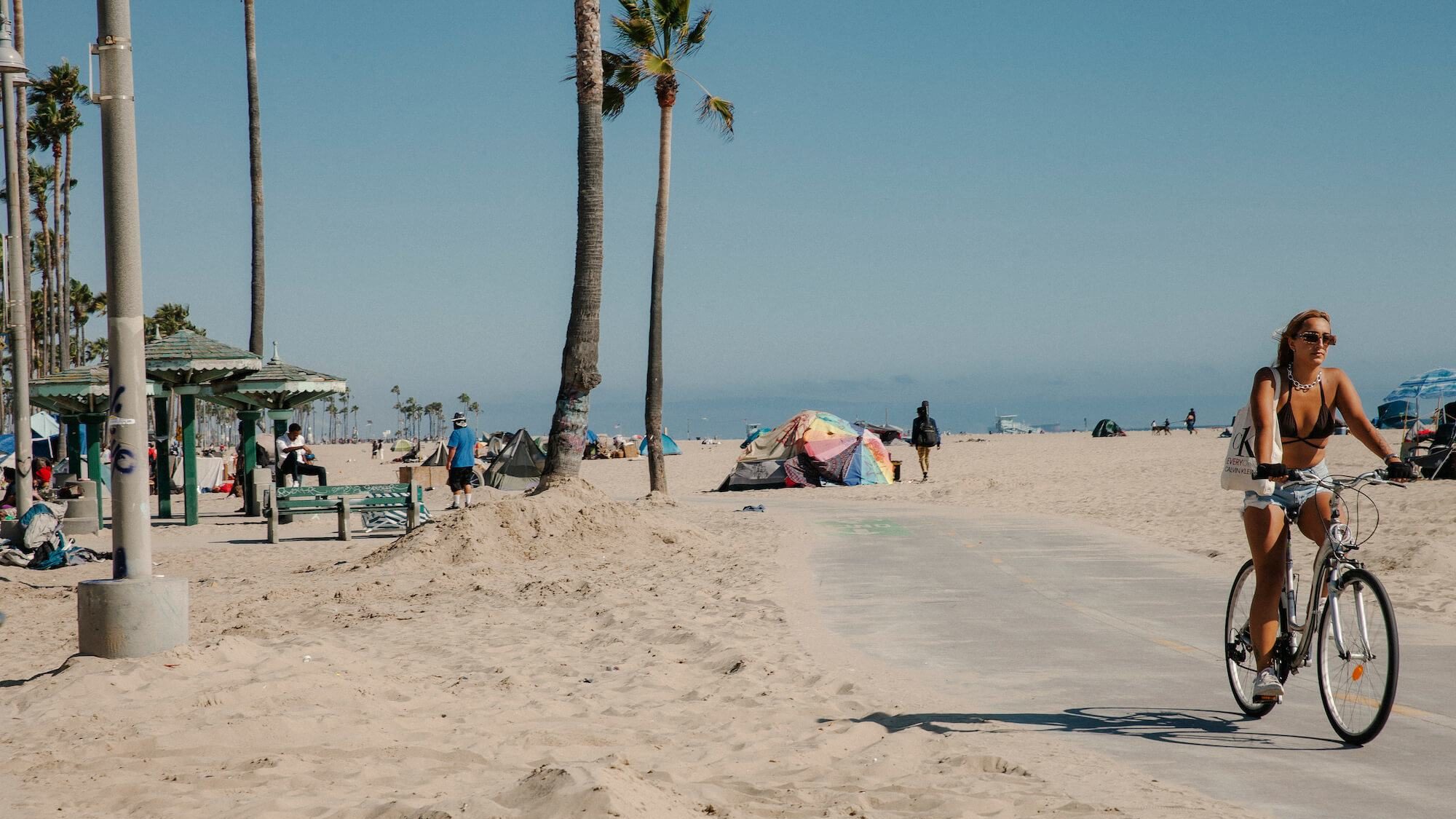
The boardwalk and bike path have remained relatively clear since the midsummer clean-up, but the inland encampments cycle back and forth, and if they get cleaned up new settlements pop up nearby.
Samanta Helou Hernandez
Voters had approved a bond measure in 2016 that would have authorized up to $1.2 billion in housing funds. Legal challenges delayed action until 2018, and a year after that the conversation turned to whether shelters were a better idea than permanent housing, which meant further delays. He wasn’t the only one to wonder why construction on some projects seemed so expensive, and why land south of Los Angeles International Airport wasn’t being considered more seriously as potential space for new housing.
Francisco had yet to hear answers that satisfied him—in fact, they only confirmed his suspicion that people were making money off either inaction or questionable projects. He’s debating whether to continue at the Chamber of Commerce after his current term expires next summer, and in July he retired from the Venice Neighborhood Council. He closed our conversation with his rewrite of the last lines of Chinatown, a movie about an earlier, more corrupt Los Angeles.
“It’s Venice, Jake.” There was pretty much nothing left to say.
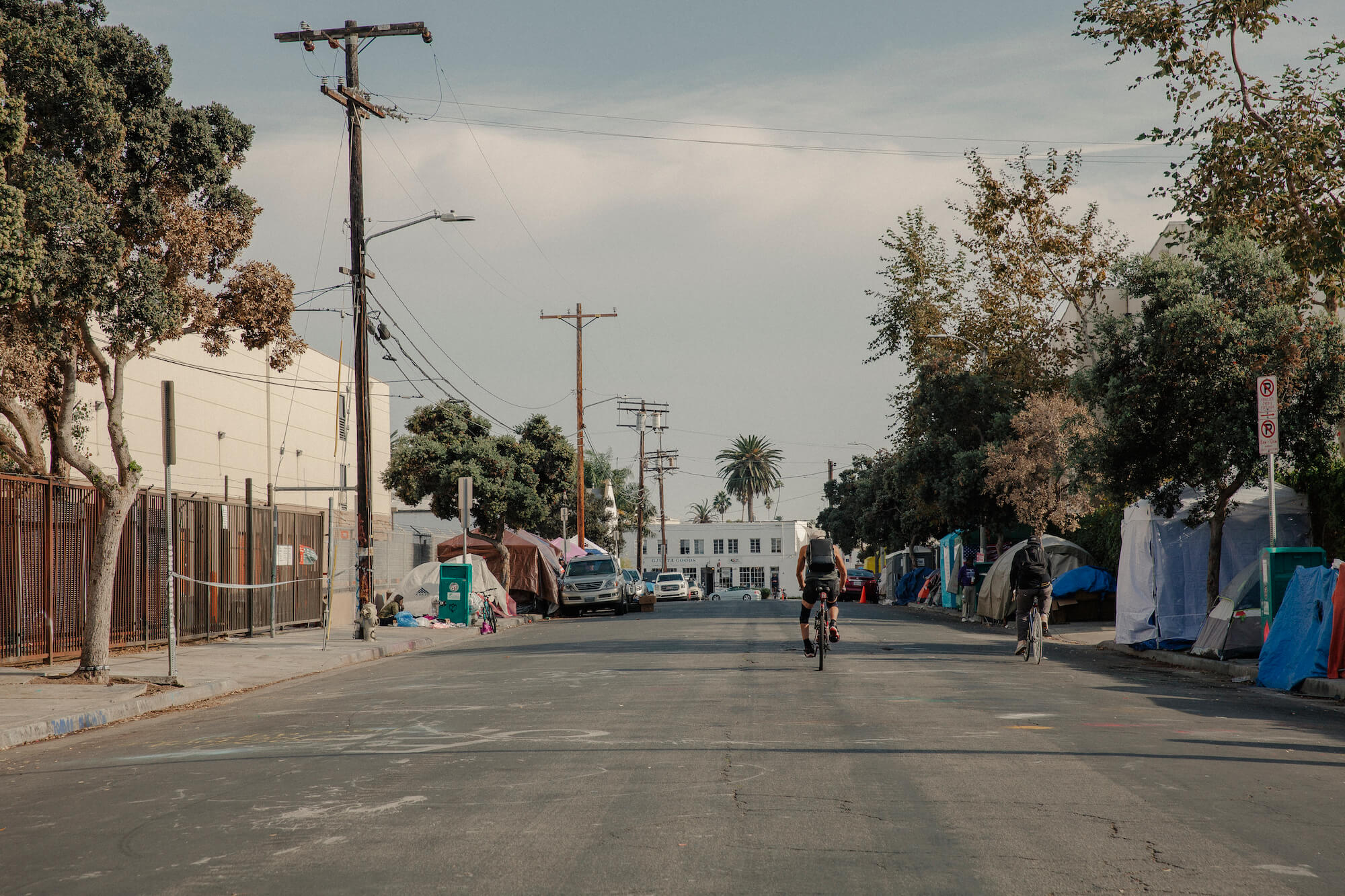
Third Avenue has a block-long row of tents on both sides of the street, except for the area in front of the storage facility, where barbed-wire fencing went up inside the existing fence.
Samanta Helou Hernandez
Developers, a group with a vested interest, stayed silent by choice. But Phil Brock knew what they were up to, and that they might already be deciding Rose Avenue’s fate. Brock, a longtime Santa Monica resident and first-term city councilman, comes to the conversation with a unique set of credentials: He was mugged in Venice at gunpoint along with his wife, in 1980, and won’t live there, he said, because “I like the eclectic and creative, but I don’t like the danger that’s mixed in.” He inherited two rental properties from his father, in 1997, and lately had fielded cold calls from developers asking if he’d like to sell his four-unit rental property across from the storage facility and the Third Street encampment. He turned them down, but he knew what the overtures meant. They’d like to be in his shoes, in line to make a great deal of money when today’s Rose Avenue yielded to what they assumed was coming, a repeat of what had happened to Abbott Kinney.
Brock hoped they were wrong, because there were customers—he considers himself one of them—“who don’t want a repeating pattern of the same stores and restaurants over and over. Rose Avenue is what many people want. We want to go where the locals go, go to the indies, they want to be first on the scene and find something new and different.”
“Three, four years from now, Rose Avenue follows Abbott Kinney, and you force out both the current residential and the commercial.”
But there were relative bargains to be had on Rose, and no guarantee that the developers who approached Brock cared about preserving the street’s character.
“Rose Avenue prices are lower than Abbott Kinney,” he said. “And developers want to buy on Rose because on some blocks, at least, you can do mixed-use, maybe have some ground-floor retail. They’re imagining it’ll all be cleaned up eventually, so if they can get in now and hang on long enough, they’ll make millions.”
In Francisco’s dire scenario, Venice remained a neighborhood of extremes, and nothing got fixed. In Brock’s, the value of beachfront property would eventually prevail. The specifics of what would happen to Rose Avenue’s unhoused population, in either case, were yet to be determined—precedent ran from tiny-house developments to safe-parking areas to the sudden dismantling of the Echo Park encampment, to solutions that would take years. But one way or another, Brock anticipated a tectonic shift.
“Three, four years from now,” he said, “Rose Avenue follows Abbott Kinney, and you force out both the current residential and the commercial.”
“It feels inevitable,” he said, “though I’m not entirely sure.”
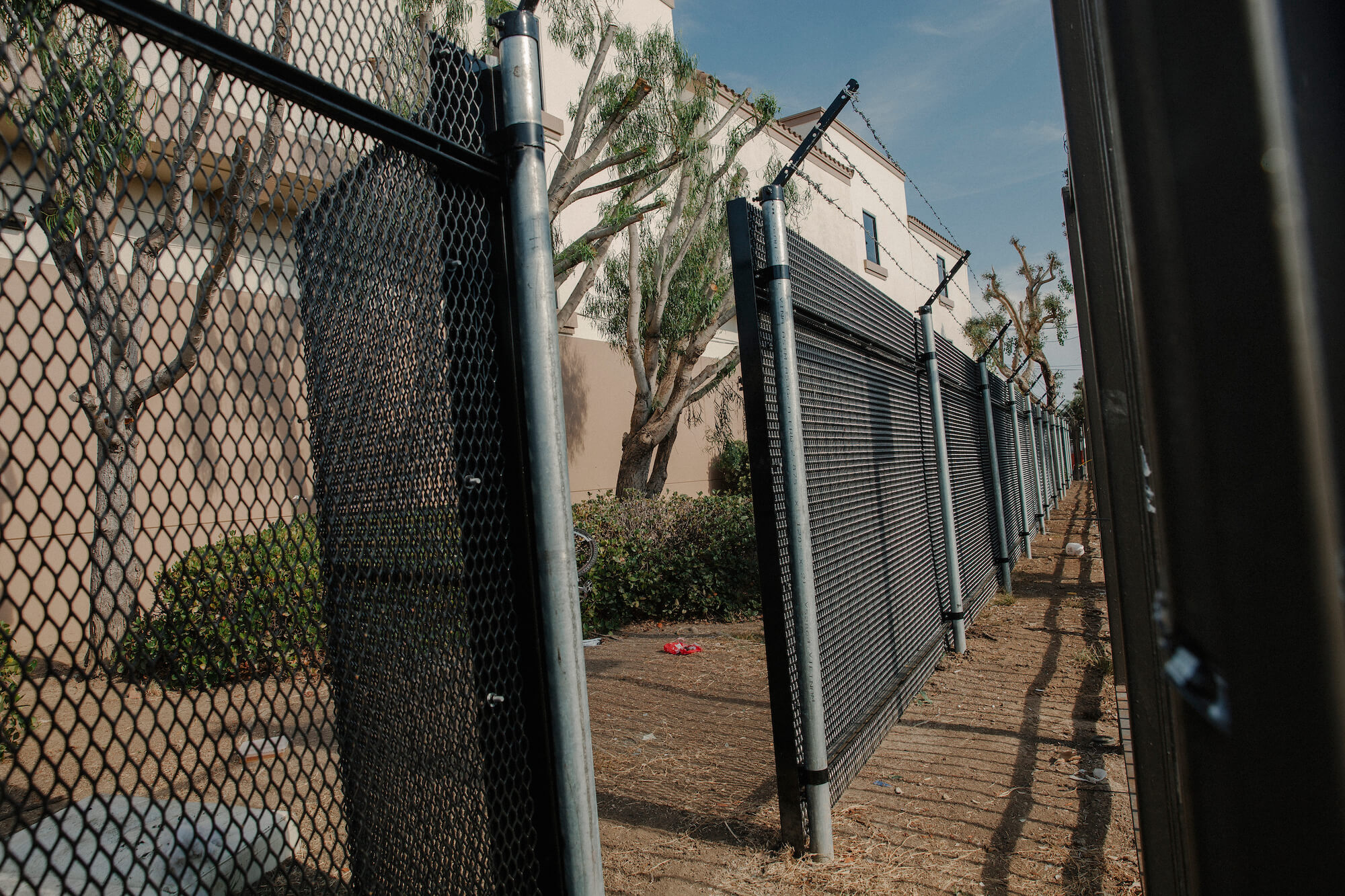
A new storage-facility barbed wire fence, meant to deter people who’d been sleeping on the property, like the person who left behind the mattress.
Samanta Helou Hernandez
No one was, about much of anything. Half of the sidewalk on the east side of Third Avenue was emptied out to make room for a construction project at the storage facility—a new second fence installed inside the existing one, this one topped with barbed wire to discourage people like the one who had abandoned a mattress inside the first wall. A cleaning crew returned to empty half of the west side of Third, a job which lasted a couple of weeks before people circled back and set up their structures again.
In May, the neighborhood homeless population had occupied a geometric grid. By the end of September they were floating in various directions, dislodged, but not gone. Not housed, most of them. Just moved.
And Neroni gave little ground: If things were better for him by the fall, and maybe they were by a little bit, it had nothing to do with the city’s revived efforts. It had to do with him closing the rear entrance to the restaurant, beefing up the staff at the front entrance host stand, and being quicker to call security.
On November 10, supporters of the effort to recall Mike Bonin submitted about 39,000 signatures for the city to review. If just over 27,000 are valid, a decent bet, Bonin will face a recall election in May, weeks before the June general election in which he hopes to win a third and final term.

Ocean Front Walk at summer’s end.
Samanta Helou Hernandez
Mr. William Earle Jones’s motorhome was in the same spot in September, as immobilized as ever, even as a neighbor worked on her camper because she’d heard rumors that street cleaning might eventually get to the eastern end of the street. I couldn’t find Georgeanne Ayers, whose general store was part of the first Third Avenue street-cleaning. Linda’s two tents disappeared and a scruffier one took their place, but then, one day, I saw her pulling a cart south along Hampton to what turned out to be her new home, in a less prominent location on the opposite side of the block. She said a Google employee had accused her of panhandling and told her to move, and her explanation—“I don’t ask for money, people give it to me”—seemed not to make a difference. A man who already lived on the other side of the block helped ferry her stuff to the new spot, which would be home unless the sanitation crews returned.
Small new settlements appeared on Rose Avenue around the corner from Third, in a nearby parking lot, and on a grassy triangle alongside the campers on Main Street, where someone had hung their newly-washed clothes on the chain-link fence to dry. A few tents sprung up on a side street or two, and slowly, parts of Hampton and Third filled up again.
The boardwalk and the encampment by the sand were almost empty, dramatically so compared to what they had been in June, and on fall weekends Venice Ale House was full of people eating and drinking and having a good time. But there were tents further down the sand, toward the water, and a bench or two were occupied by people who had artwork or souvenirs for sale, in front, and a blanket or tarp or tent, behind.
When I got to the base of Rose Avenue one afternoon, I pedaled north from the Ale House to the bike path, and passed a man struggling to turn a tarpaulin into a three-dimensional shelter, his belongings piled on a nearby bench. He sat down for a moment to catch his breath, just as a grey-haired, shirtless man on a bike, heading south, looked over and recognized a familiar face.
“Hey,” he yelled, veering happily toward the man on the bench. “Welcome back.”
